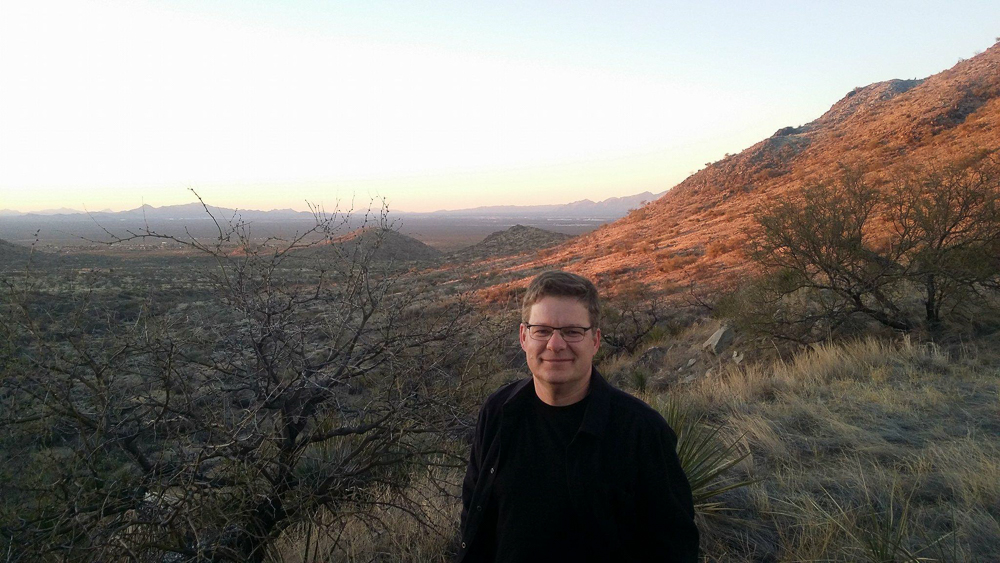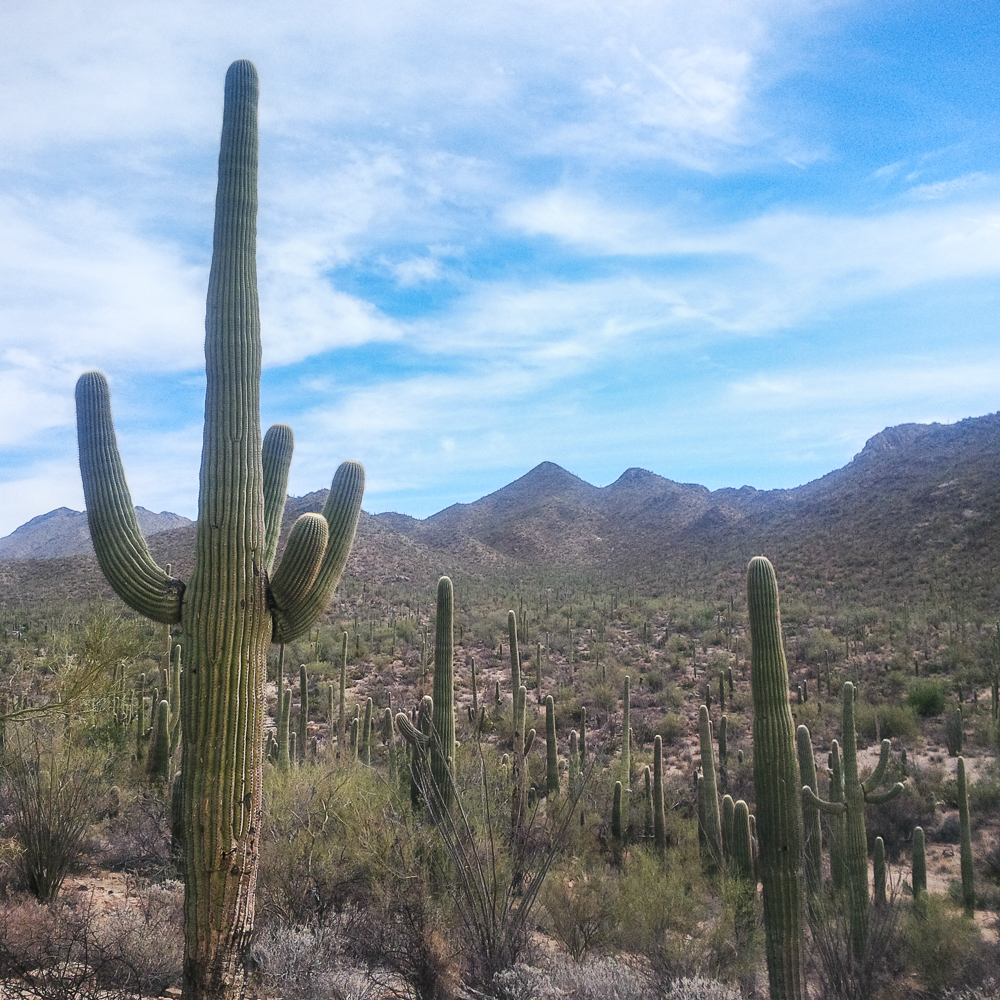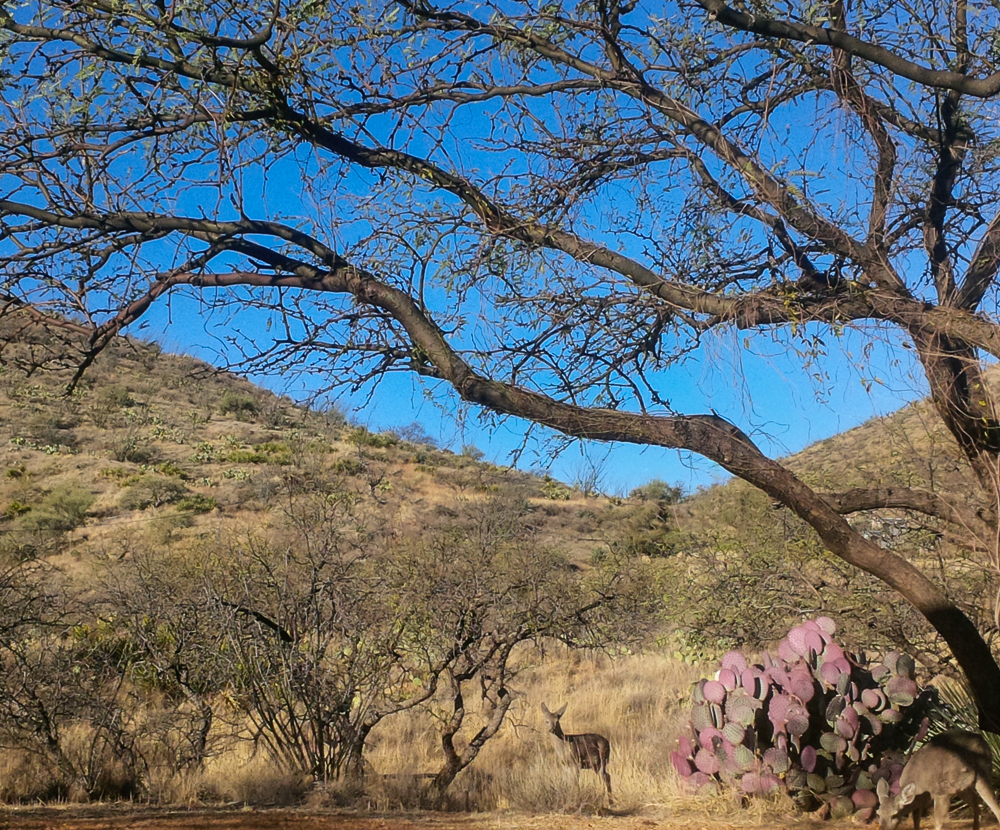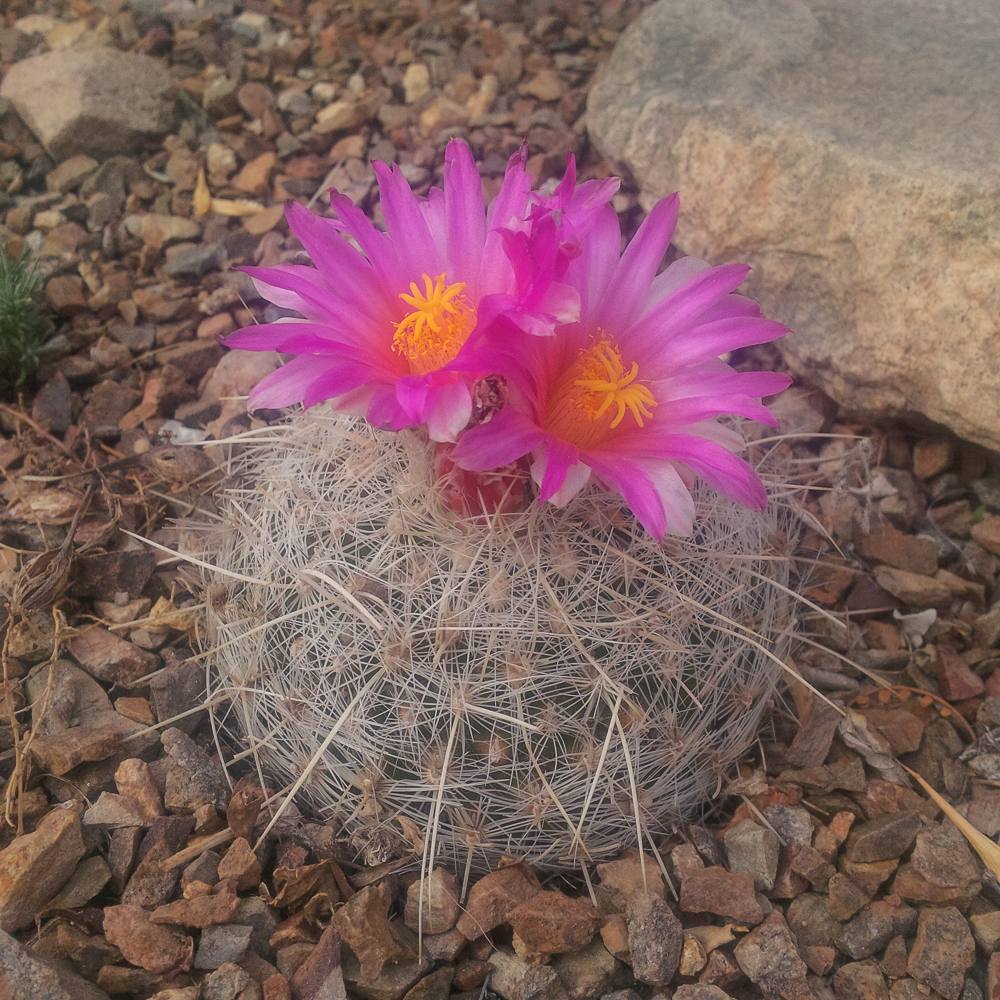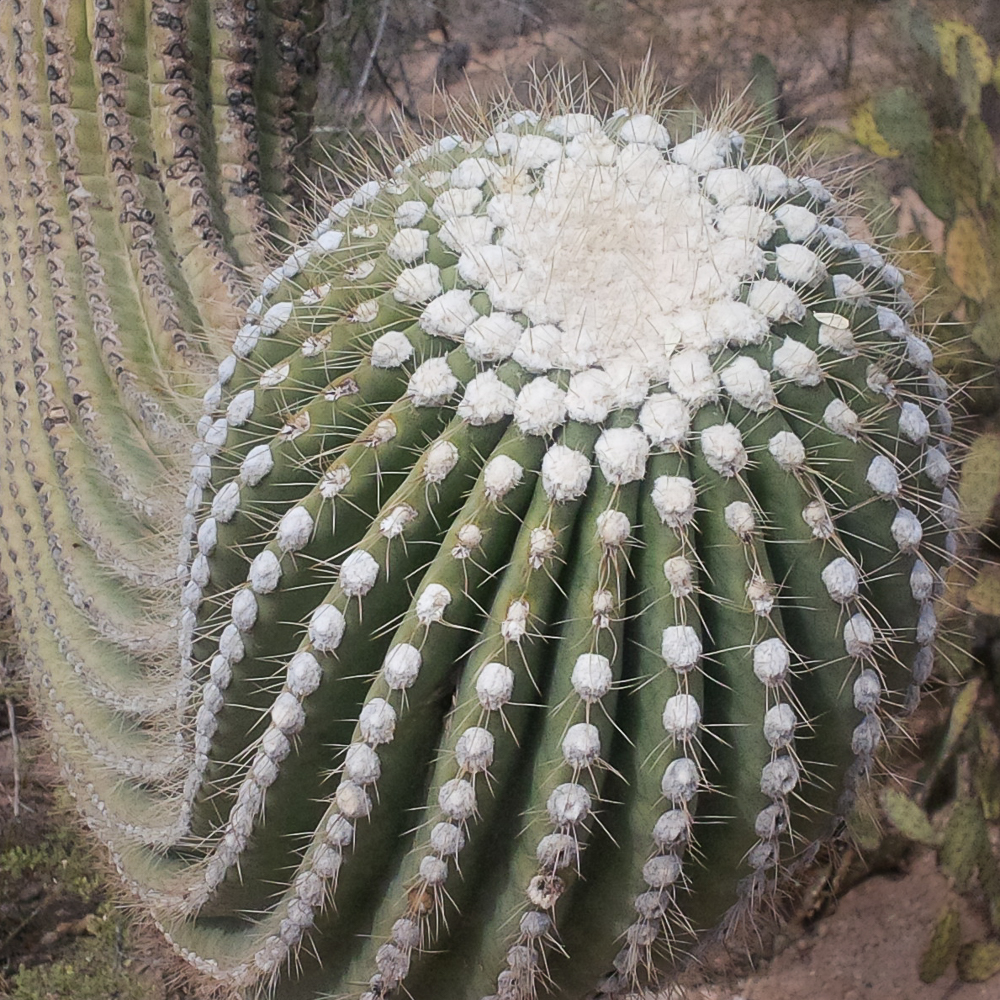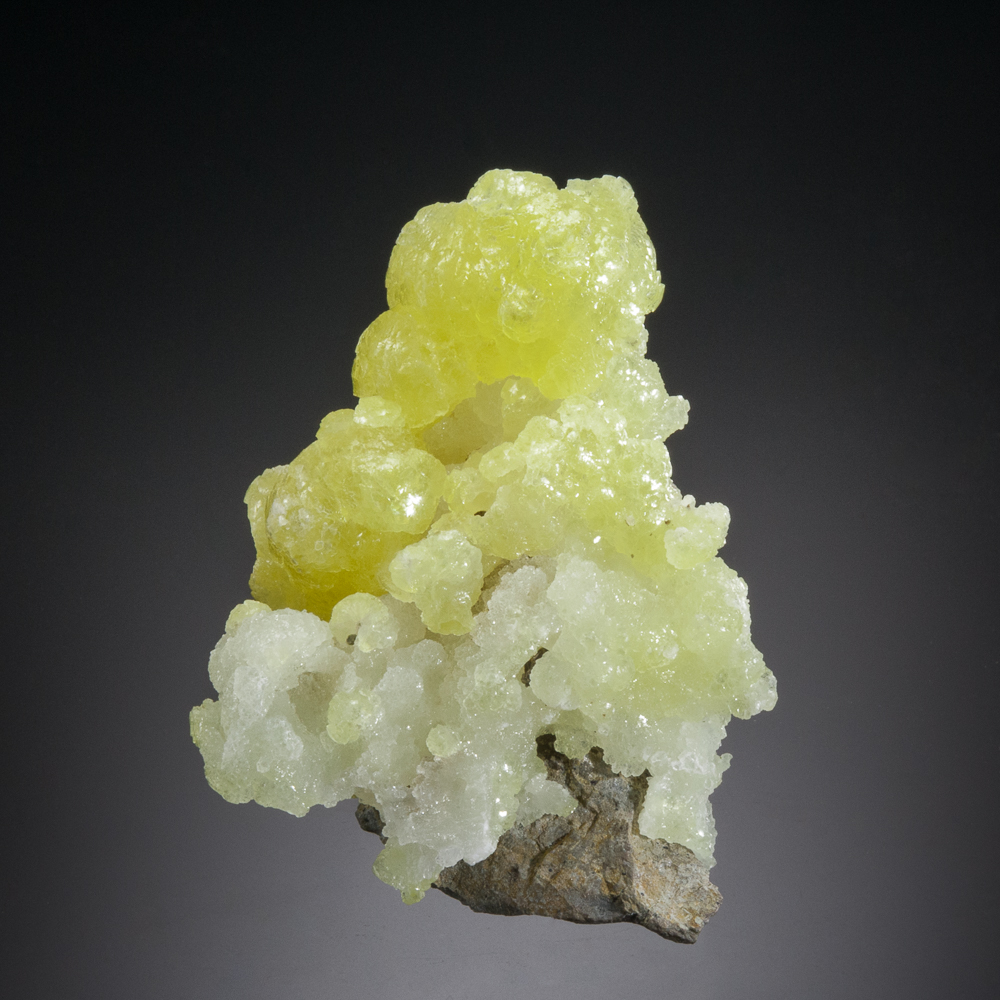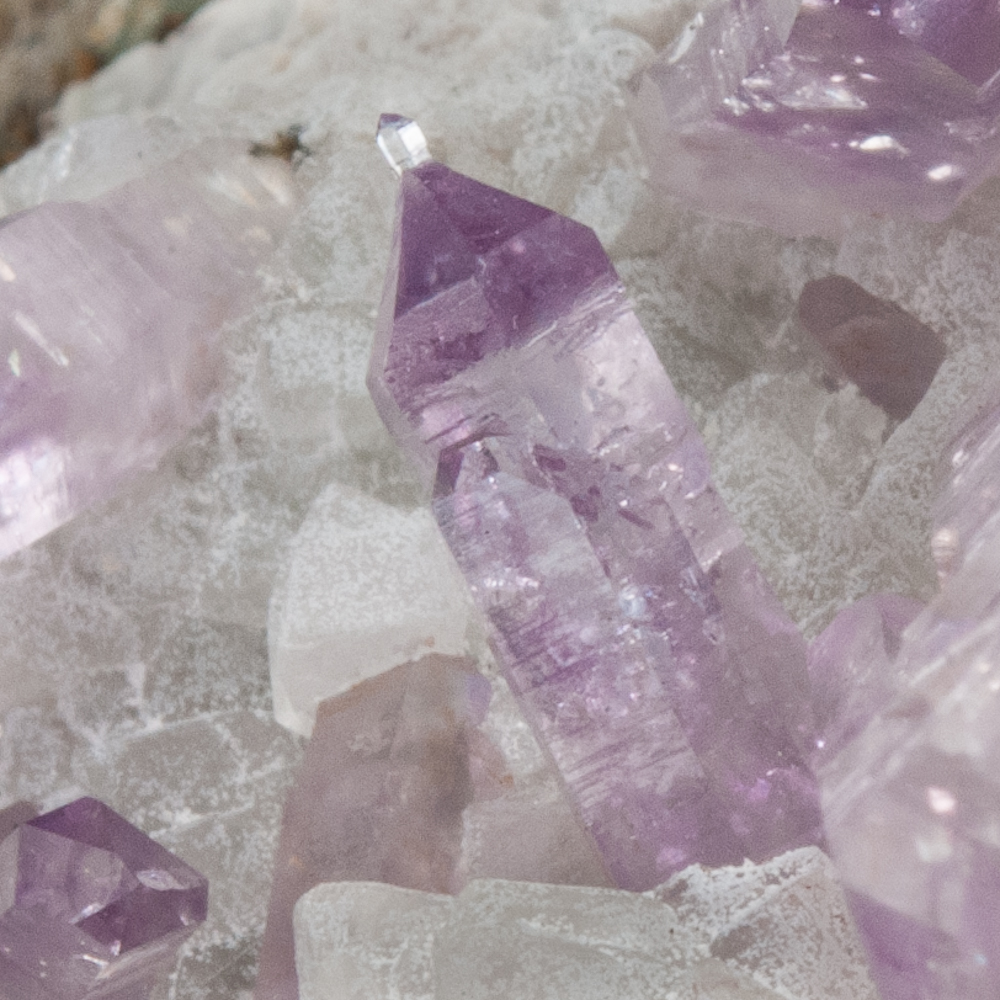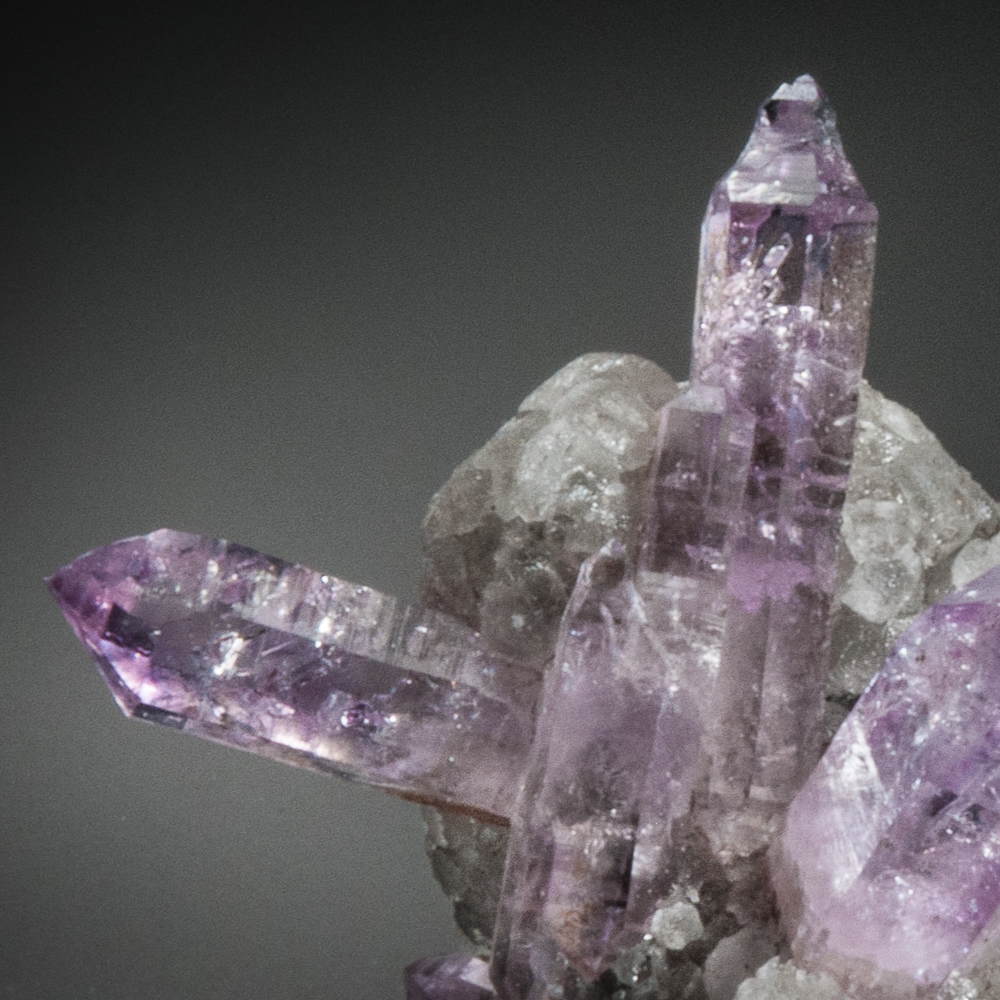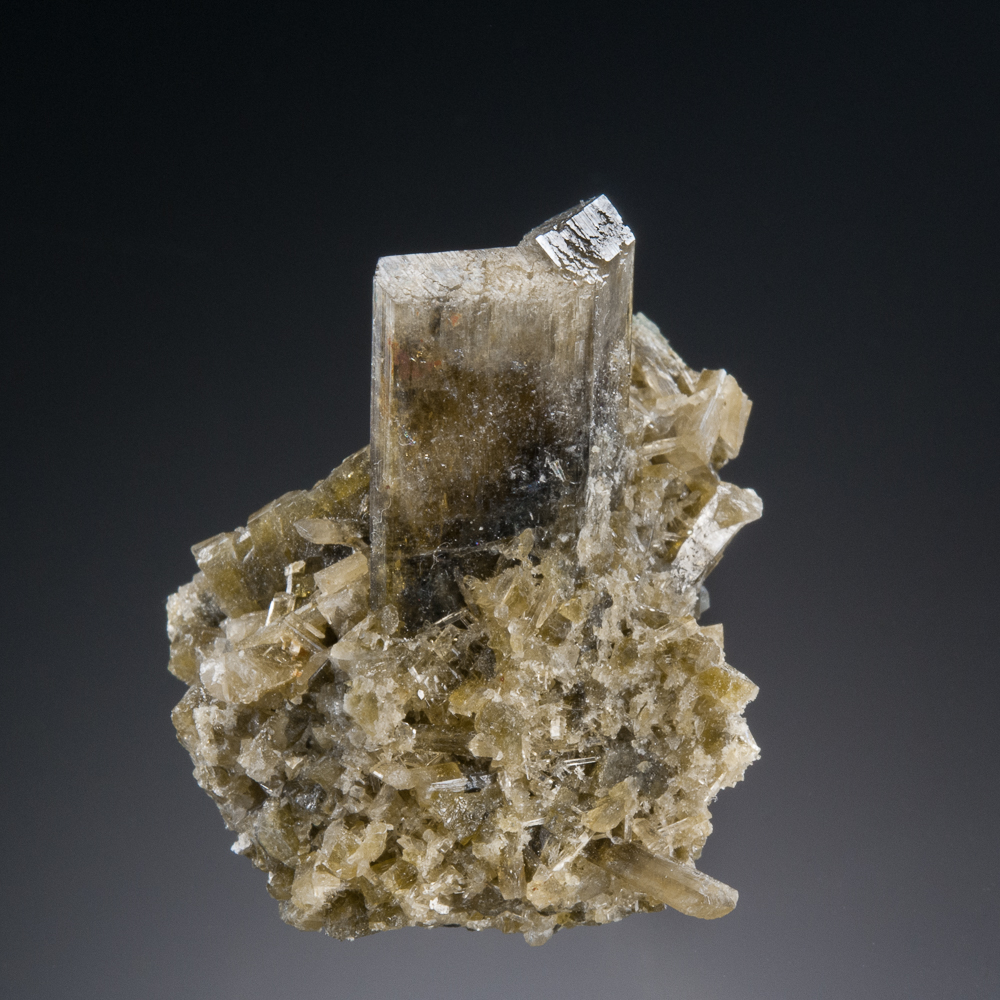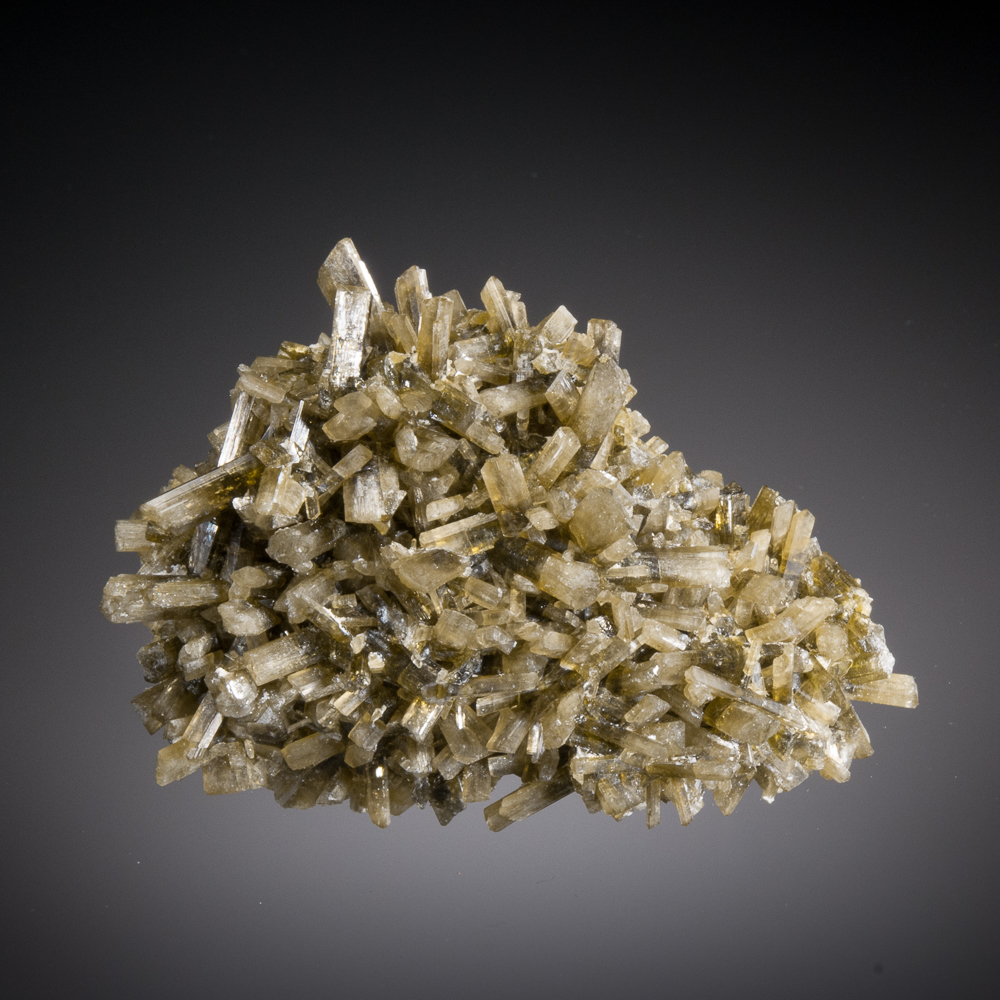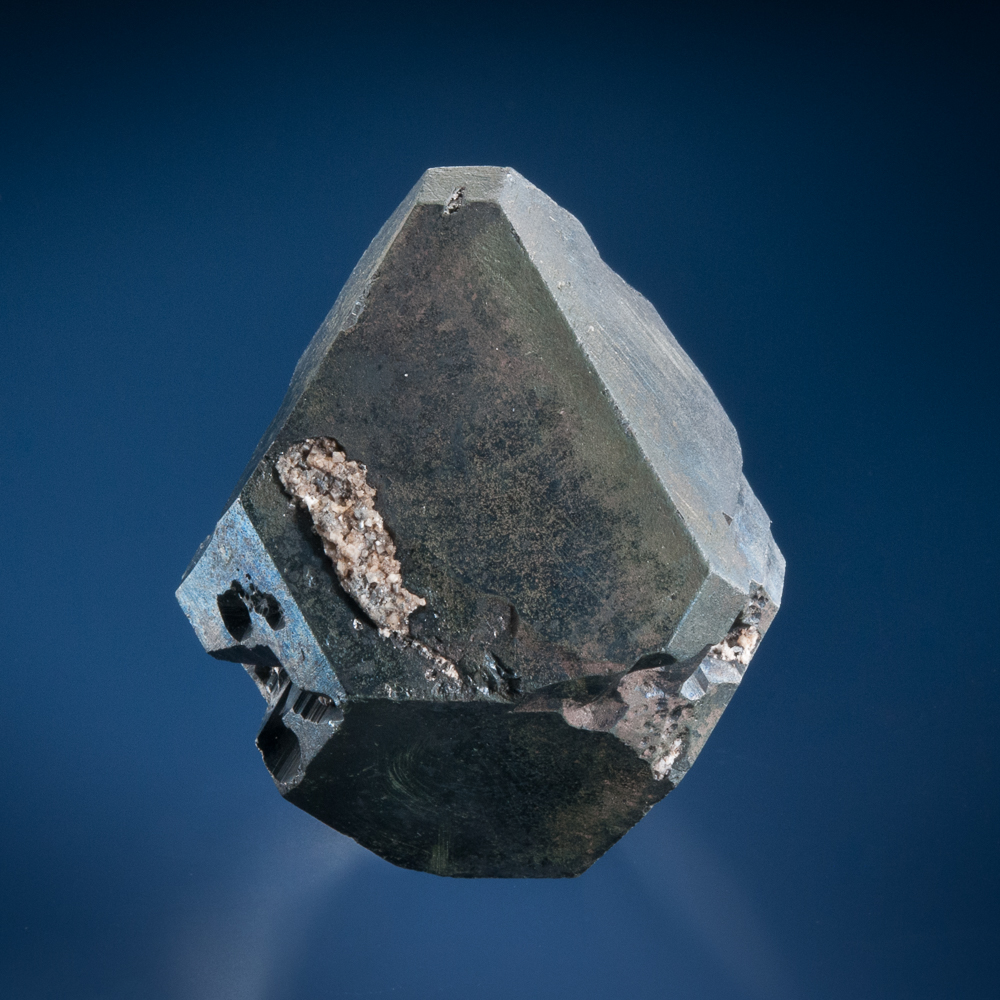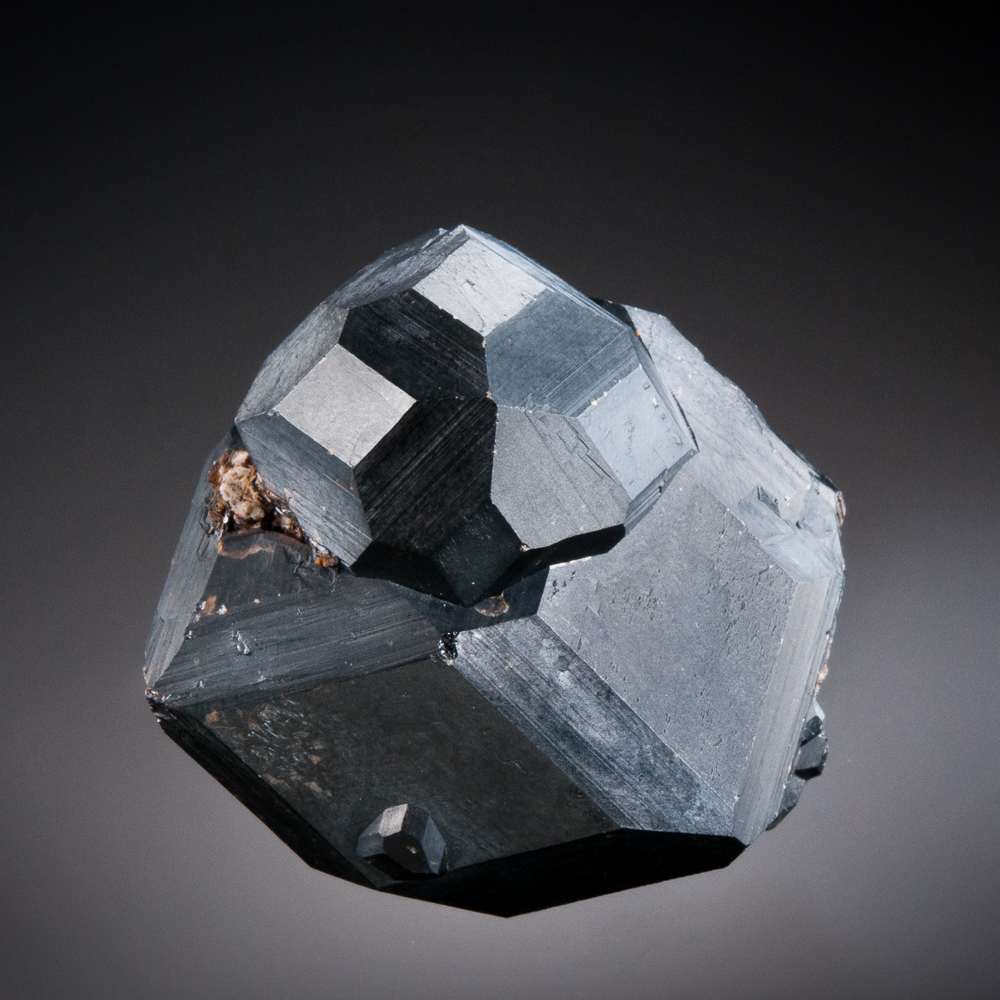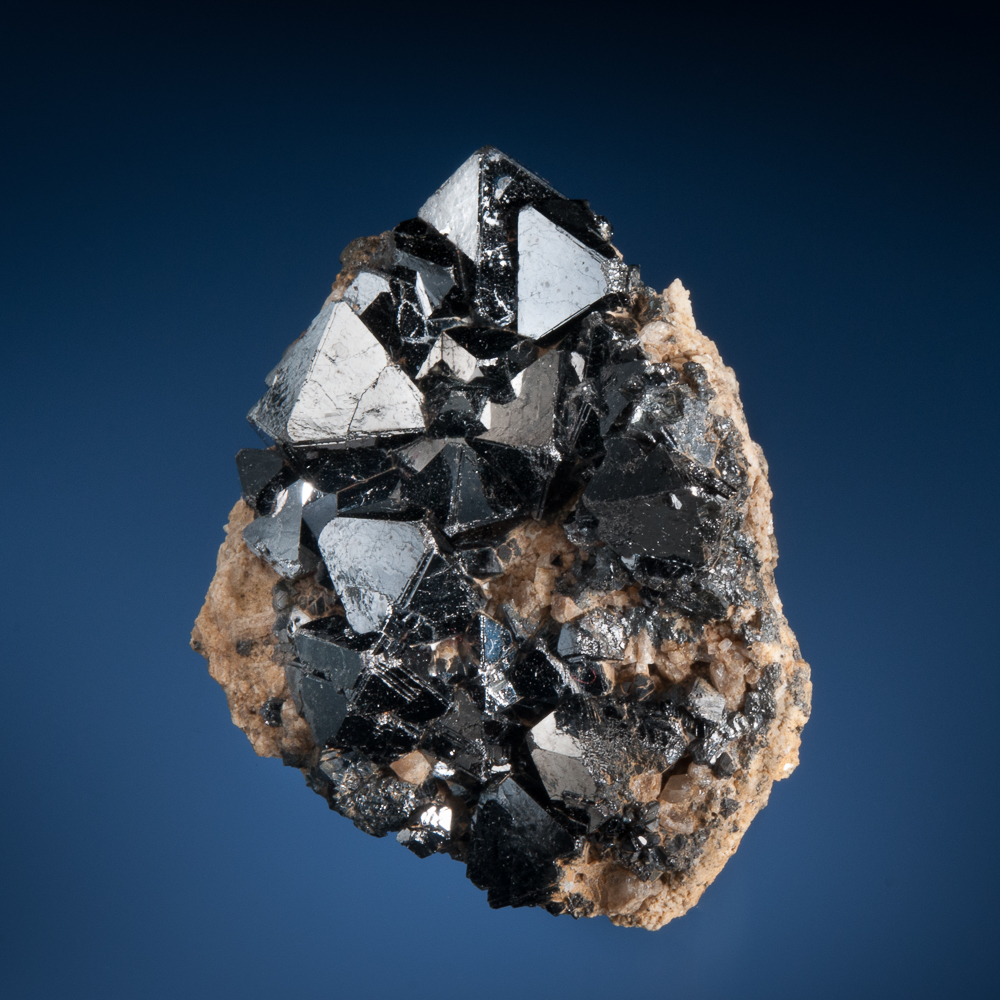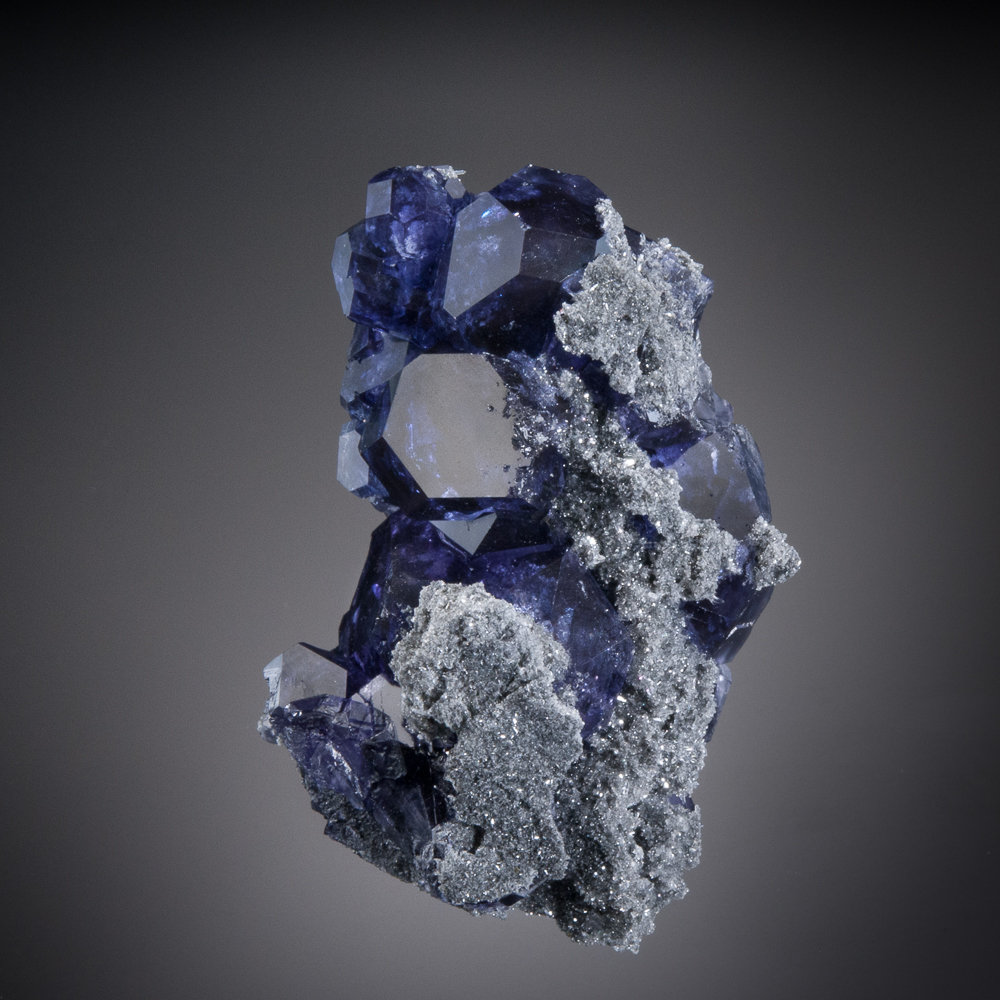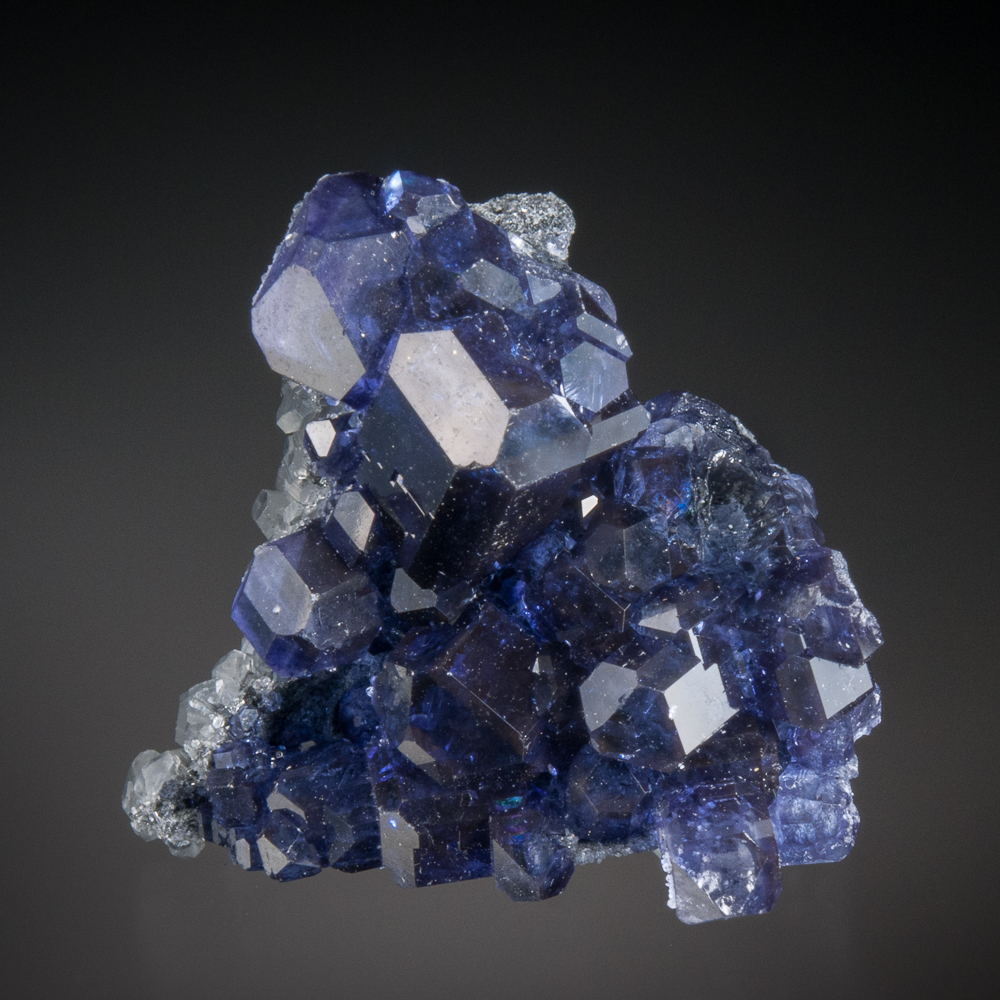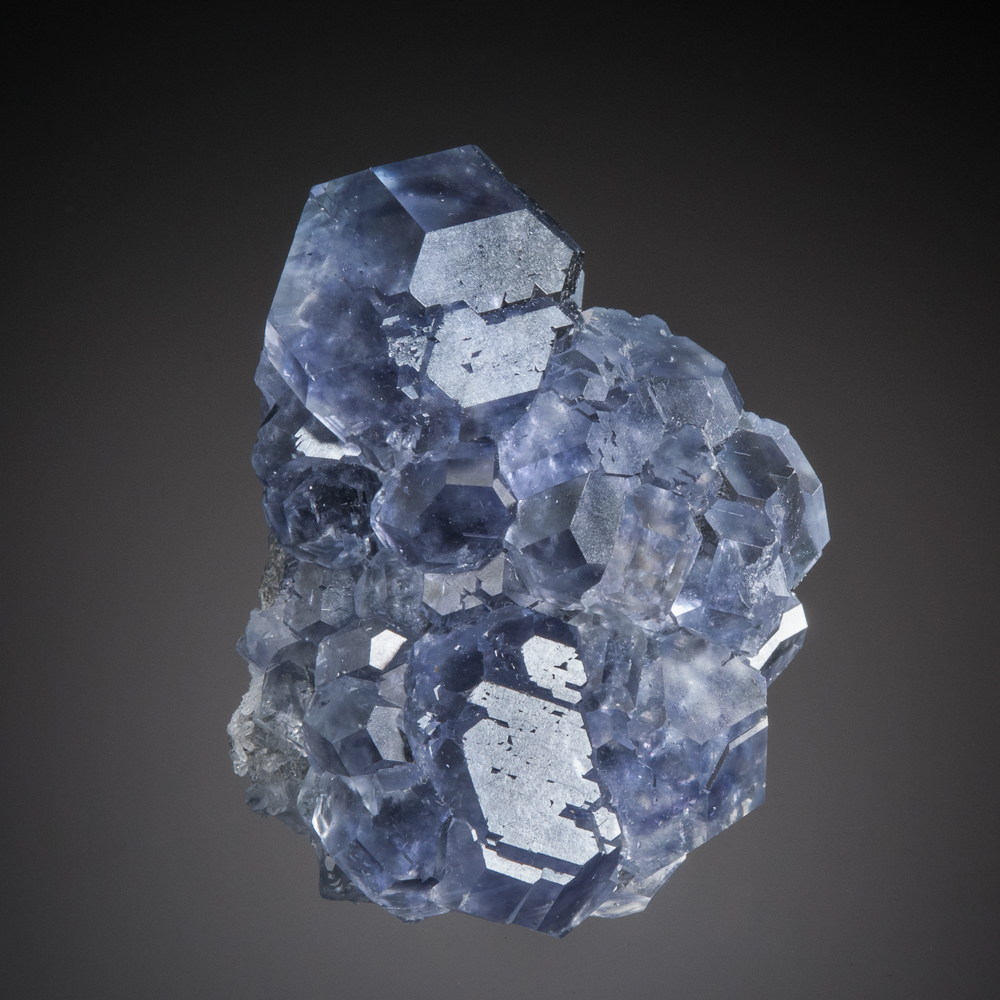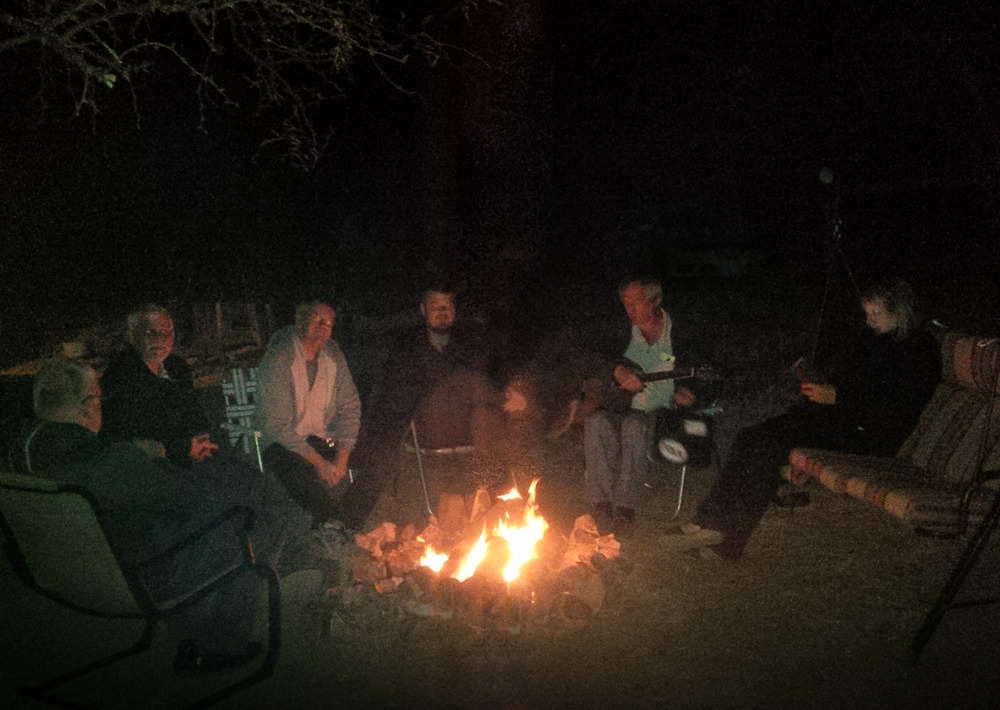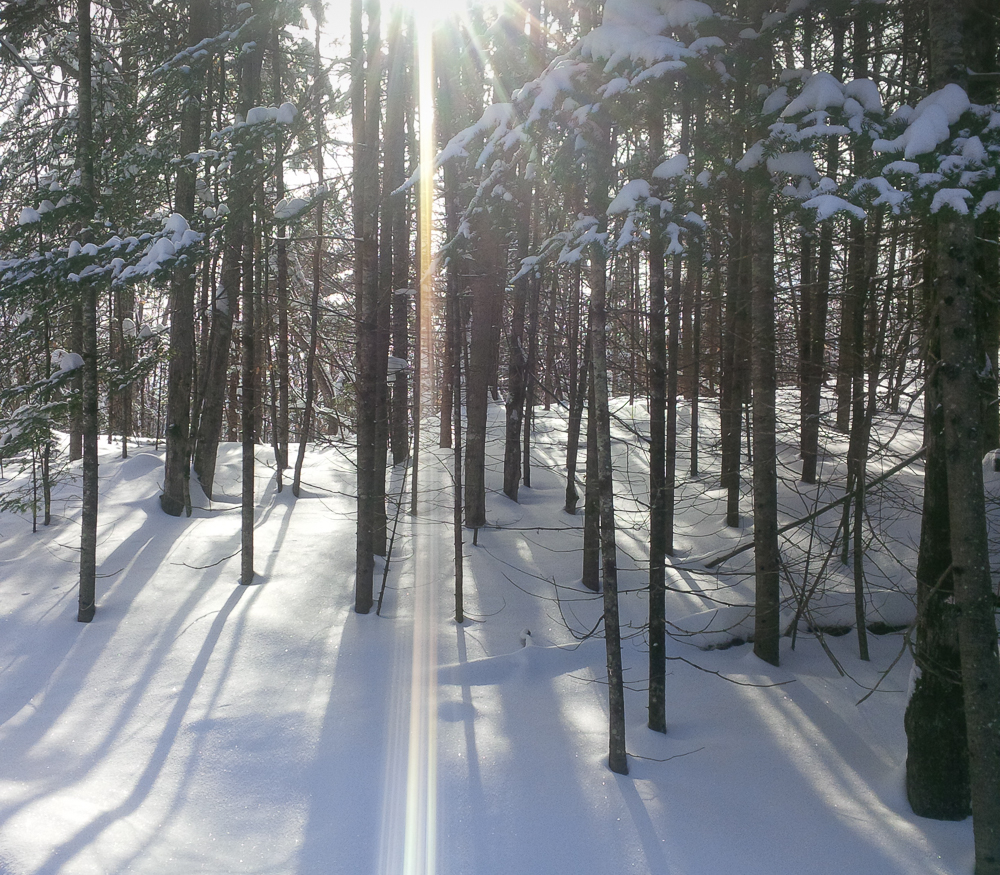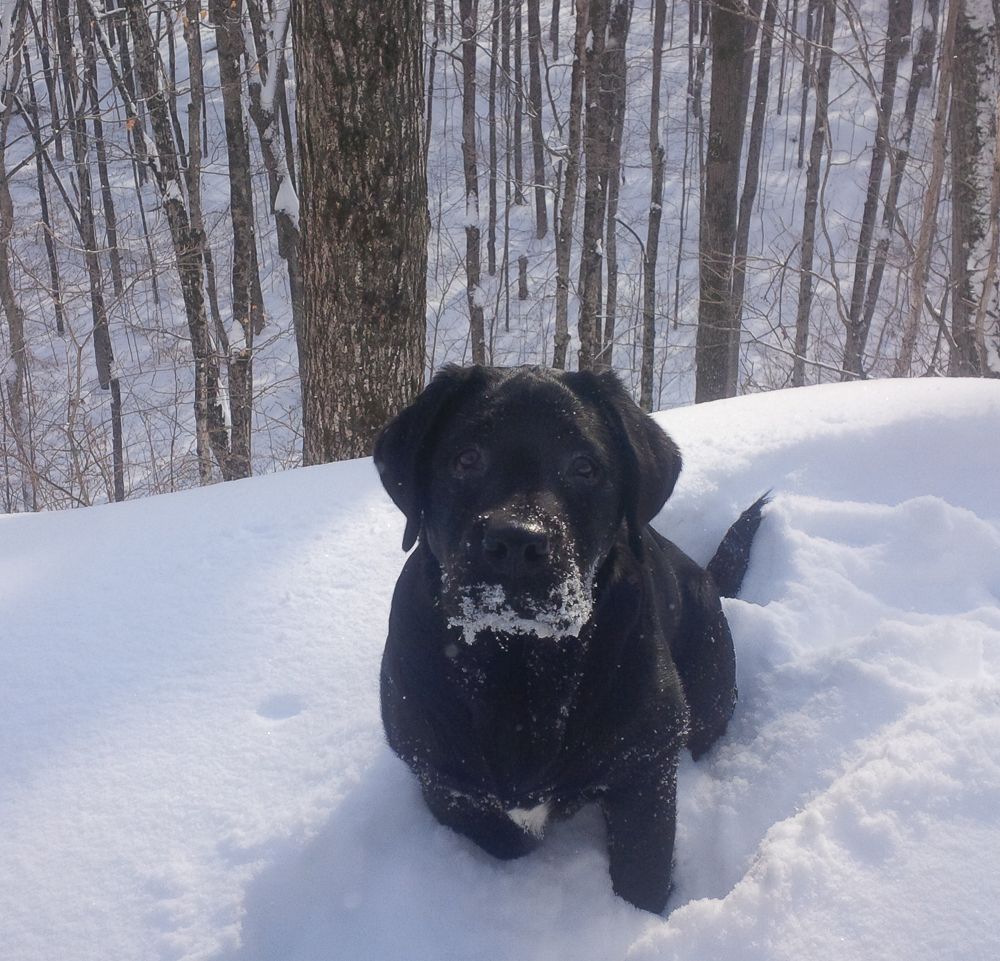Categories
Archives
It’s hard to believe that another Tucson has come and gone already. In the middle of a cold Bancroft winter, Tucson’s wonderful warm sunshine was sure welcome.
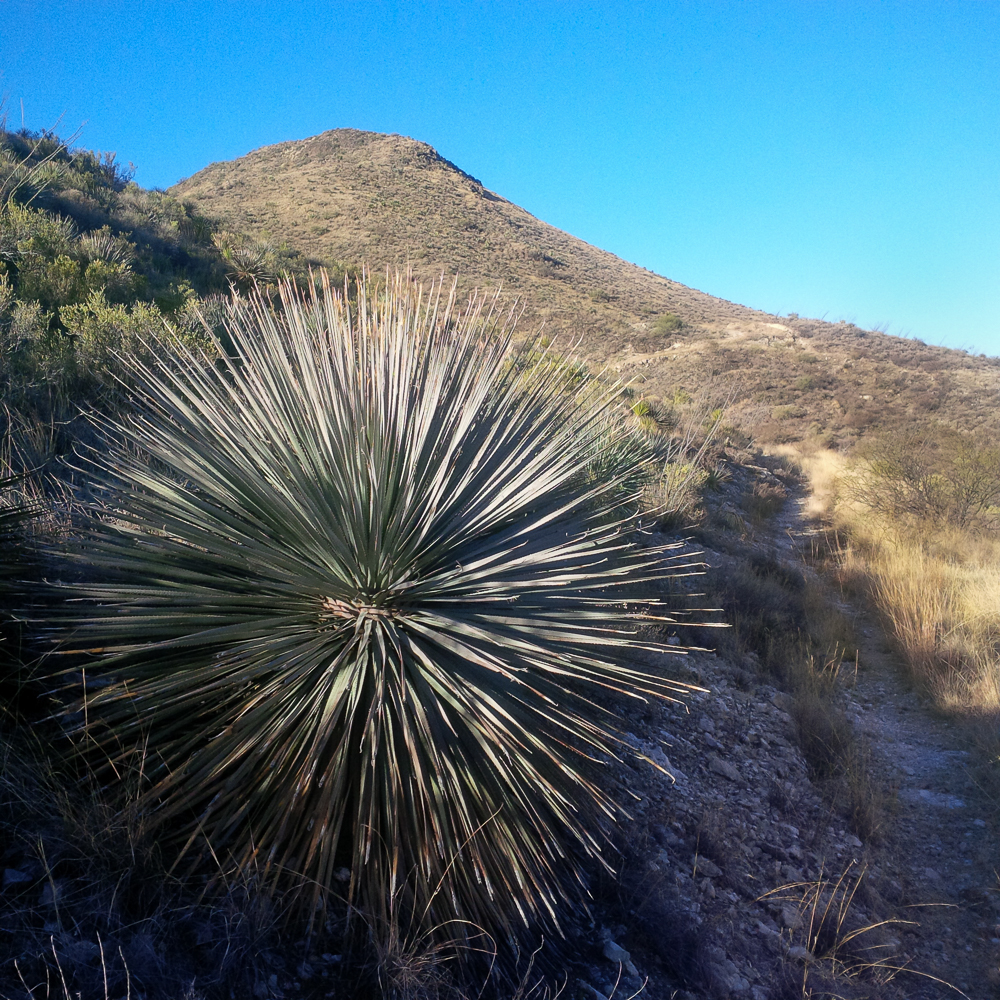 Santa Rita Foothills, southeast of Tucson
Santa Rita Foothills, southeast of Tucson
I was very fortunate to be able to experience Tucson’s natural surroundings this year. I stayed with my good friend and collecting partner David Joyce (David K. Joyce Minerals), with Carol Teal and their dog Riley at their new place in the beautiful Santa Rita Foothills, southeast of the city.
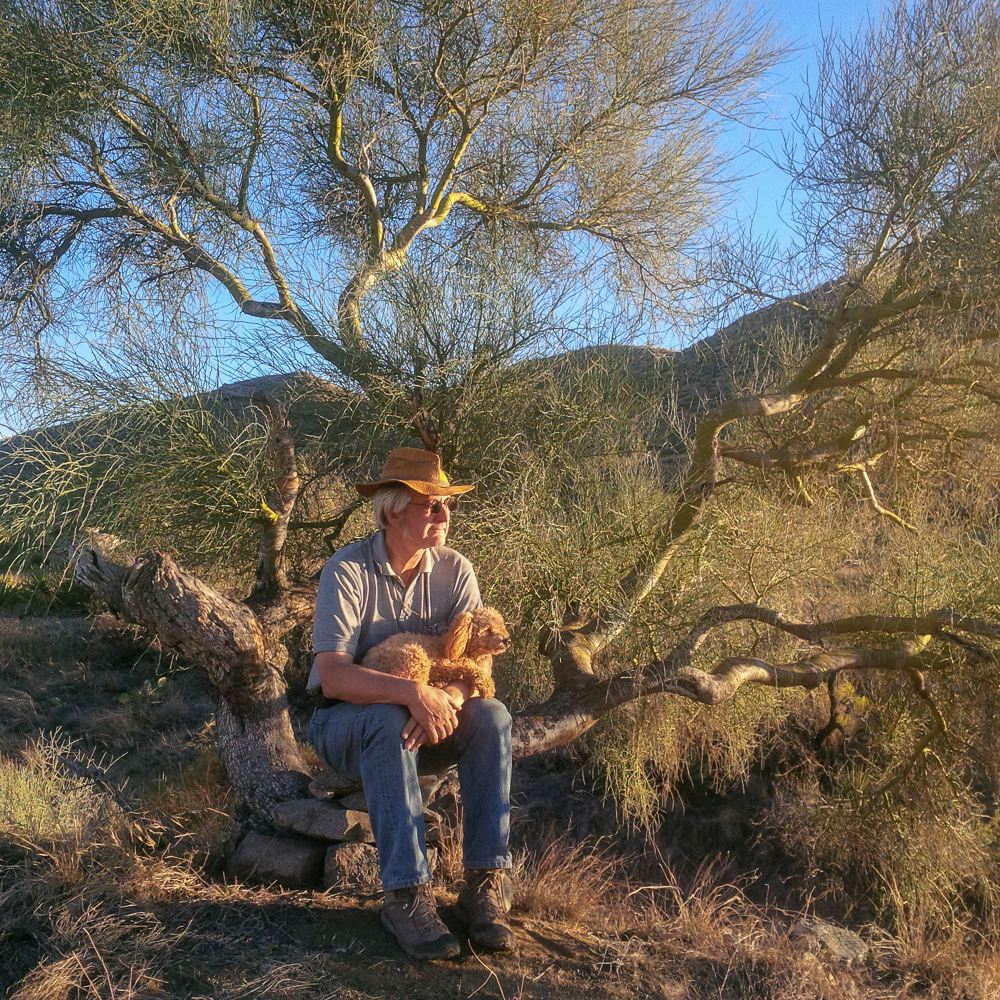
Dave and Riley on their sitting rock
Photo of me taken by Don Doell – Santa Rita Foothills, with Tucson in the distance
The Sonora Desert is a remarkable place in the world. In places, and at many times of year, it appears harsh and unforgiving. As to flora and fauna, the Sonora Desert gives the superficial impression that it is inhabited only by the hardiest very few species.
Immerse yourself in it a little, and the truth reveals itself – the variety of plants and animals is amazing (600 plant species and 200 animal species). As with everything in life, the more quiet observation you do, the more you see. The foothills and desert areas around Tucson are full of life.
Deer paying a visit to Dave and Carol’s place
Cactus bloom
On one of our mornings in the desert, the moon put on a show of its own.
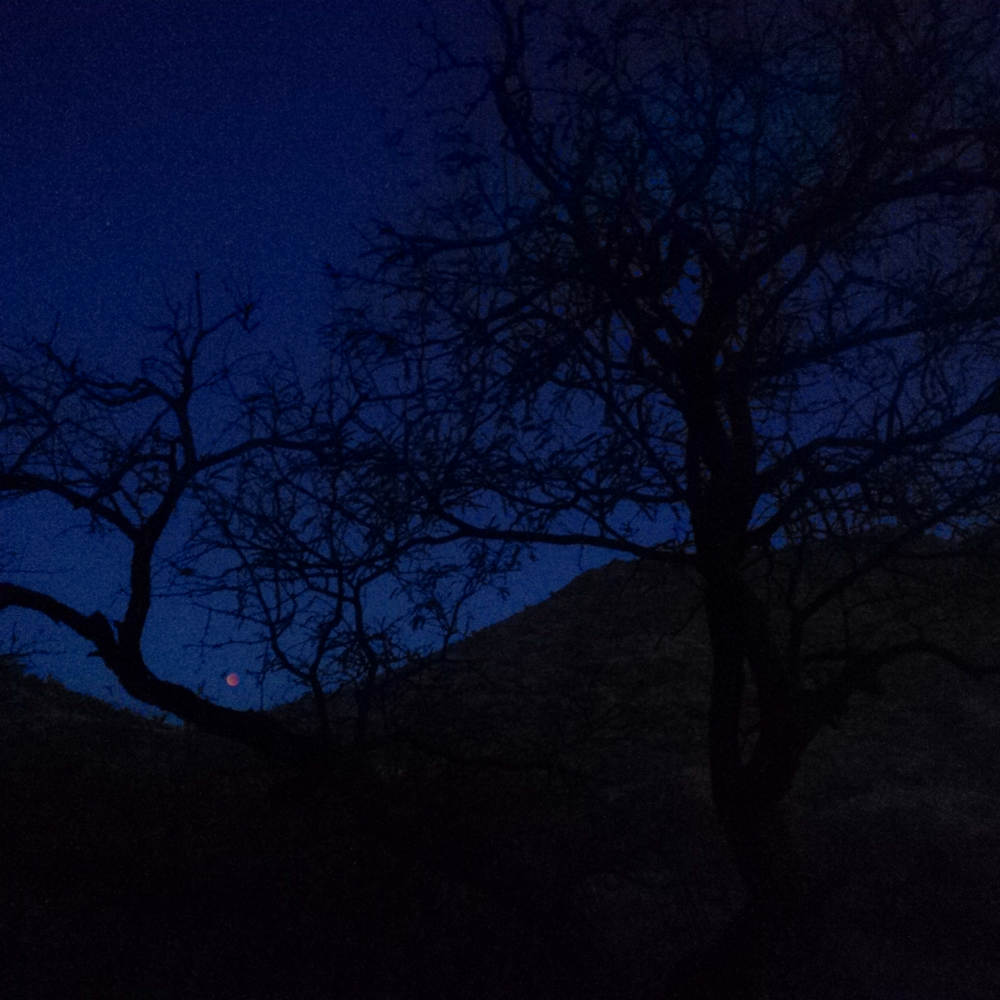 Under the mesquite trees with the lunar eclipse before dawn, Santa Rita Foothills
Under the mesquite trees with the lunar eclipse before dawn, Santa Rita Foothills
The Minerals
OK OK. I know, we all really want to read about minerals. Of course, what Tucson means is the fun of midwinter urban field collecting, and there were lots of great specimens this year.
Some beautiful and interesting specimens have continued to come from Pakistan and Afghanistan. From Pakistan, the recent brucite specimens are super – some of the finest brucite I’ve ever seen. The Killah Saifullah brucite were first noted to me by John White after he saw a couple in Munich, 2016, and since then, the quality of the finest has greatly increased over those early days. It seems that most of these are occurring in very tight seams, or with a fragmented or brecciated matrix, and so most have contacts and grey spots around them. The colour of most of them is a cream-to-very-pale-yellow, but the best have a bright yellow hue. Many are very finely crystallized, but on some, like these ones, one can easily see many crystal faces. These Pakistan brucites are amazing for the mineral.
I’ve done my best to colour-balance them accurately (daylight, shade). I always do that anyway, of course, but some mineral specimens are susceptible to really skewing away from daylight appearance when photographed.
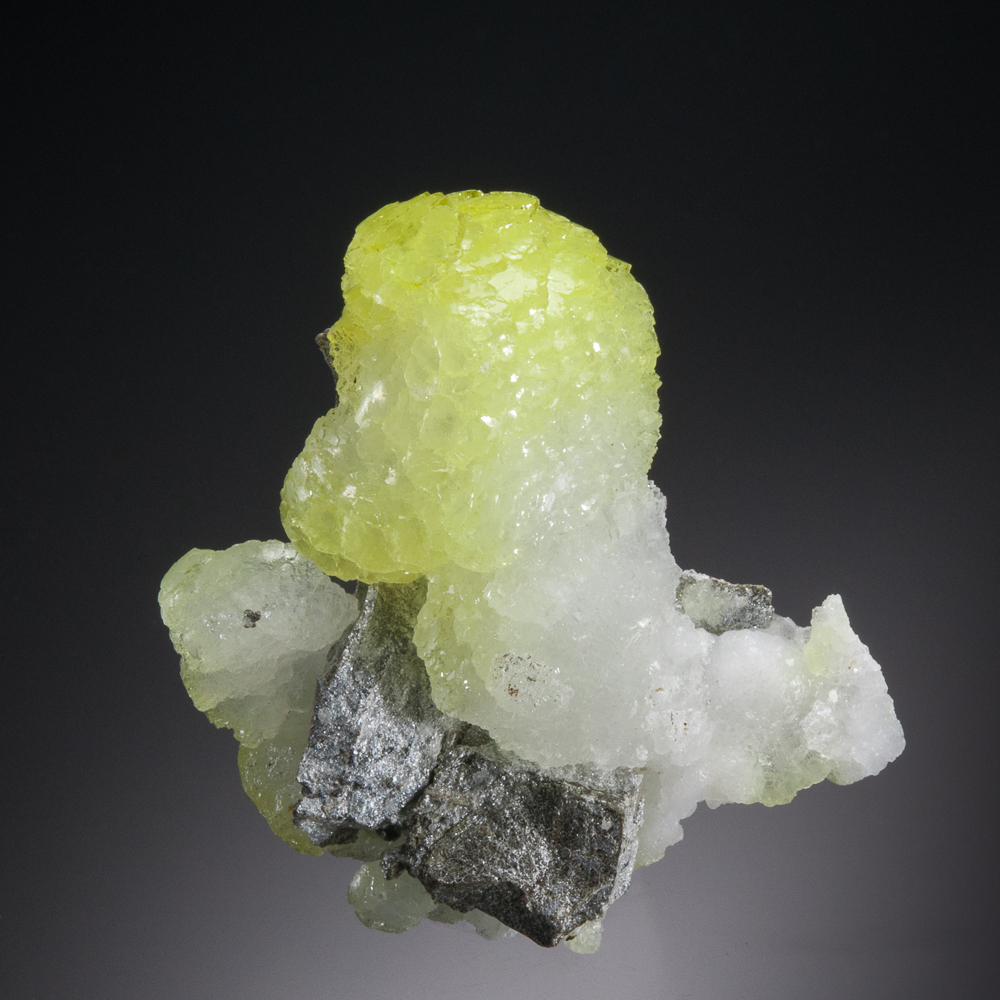
Brucite, Killa Saifullah, Balochistan, Pakistan – 6.1 cm
Brucite, Killa Saifullah, Balochistan, Pakistan – 7.2 cm
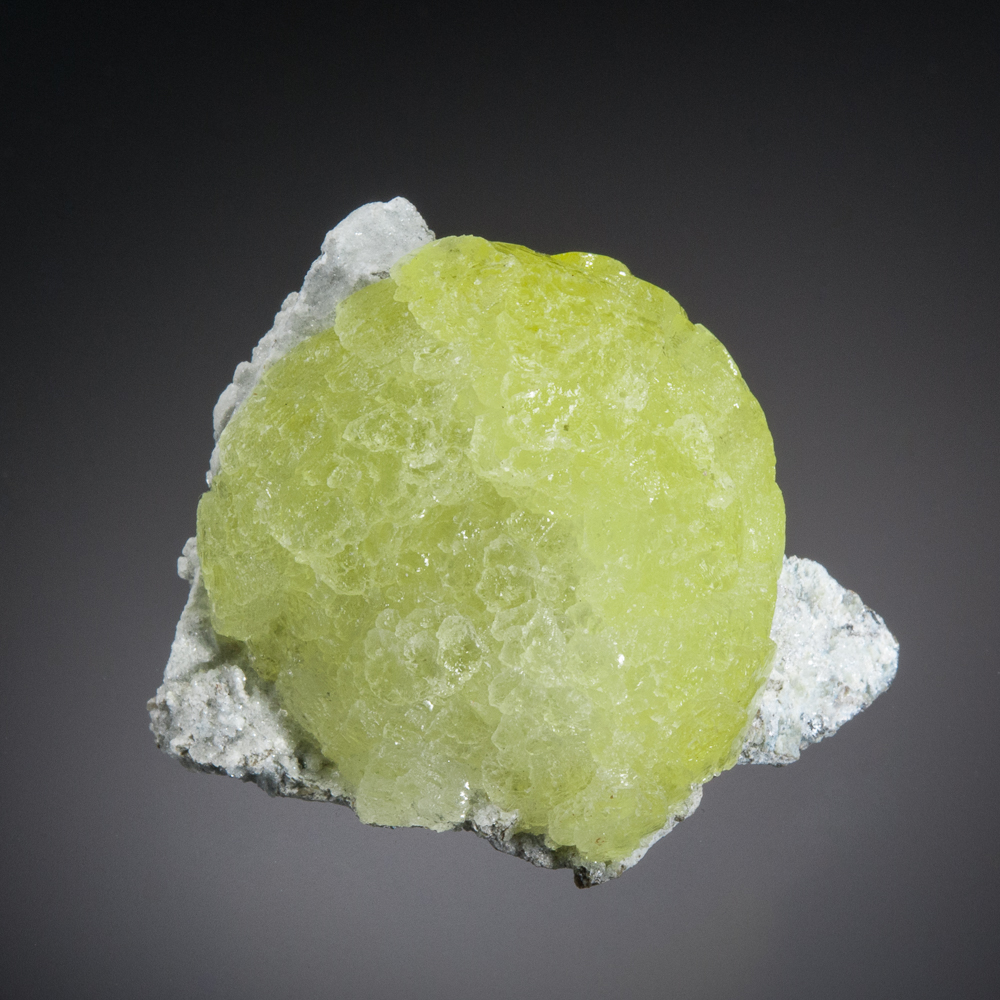 Brucite, Killa Saifullah, Balochistan, Pakistan – 3.2 cm
Brucite, Killa Saifullah, Balochistan, Pakistan – 3.2 cm
From Afghanistan, a small number of excellent specimens have continued to come from some of the best-known occurrences, and I just want to highlight one in particular. From Sar-e Sang, Dudley Blauwet has recently brought out a couple of particularly excellent diopside specimens, and I am including one here. Given that diopside is not an uncommon mineral, it’s surprising that great matrix specimens are so hard to find. This one is striking.
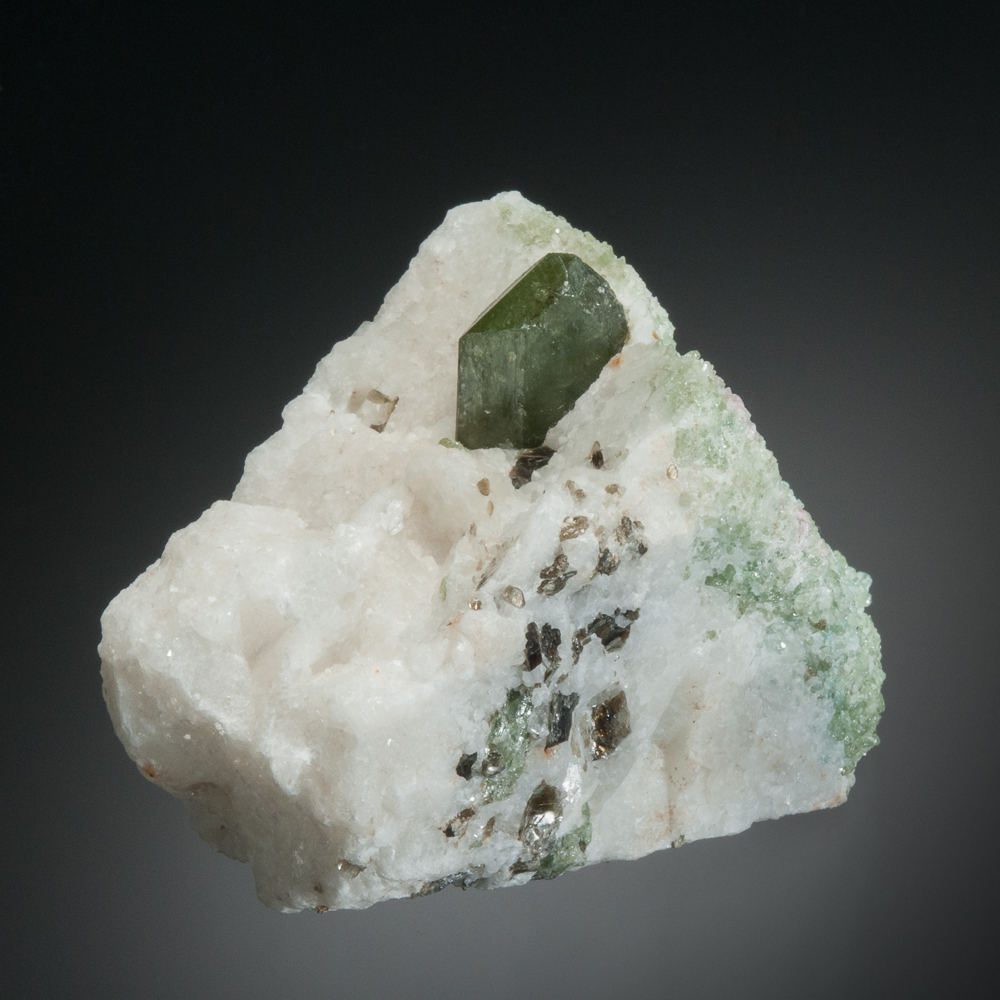
Diopside, Ladujar Medam, Sar-e Sang River, Kokcha Valley, Badakhshan, Afghanistan – 8 cm
Moving on to South America, there have been a couple of particularly interesting new finds. In Potosí, Bolivia, there has been a discovery of very pretty amethyst crystals. There isn’t more specific information about the locality at this time – I’m told that this is because it is in an unnamed area of Potosi, not near to any named settlement or geographic feature. The specimens were discovered by farmers, at the edge of a field area, bordering hills. These have somewhat similar habit and appearance to some of the amethyst crystals from Peidra Parada (Las Vigas), Mexico. They are sharp, with top lustre and excellent transparency. Some are doubly-terminated, and some show a great reverse-sceptre habit. These are really sweet – I only found them available from one person, and I acquired the nicest for the website.
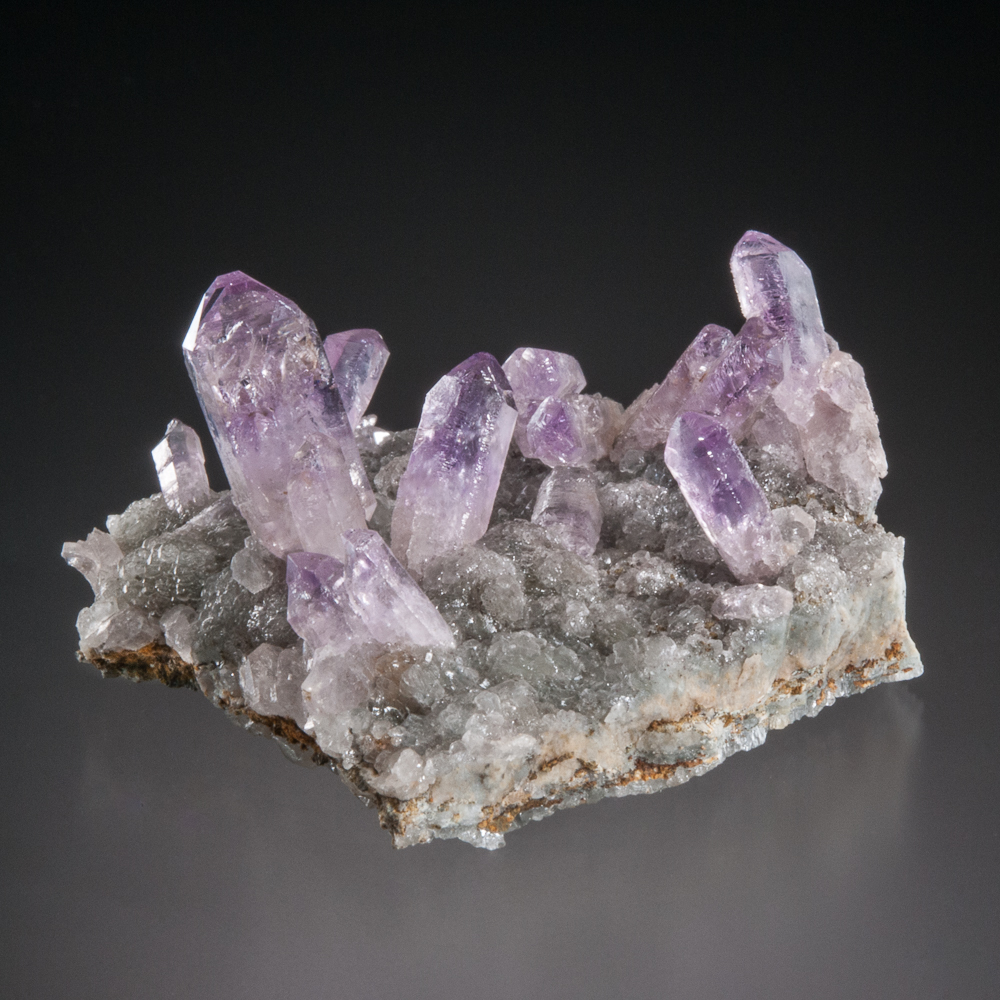 Quartz, var. amethyst, Potosí, Bolivia – 5.3 cm
Quartz, var. amethyst, Potosí, Bolivia – 5.3 cm
Quartz, var. amethyst (reverse sceptre), Potosí, Bolivia
Field of view 1.5 cm
Quartz, var. amethyst, Potosí, Bolivia
Field of view 2.5 cm
In Peru, there has been a new discovery of clinozoizite. I understand that the workings from which these were produced are only operational on a sporadic basis. The specific zone from which these specimens were recovered is apparently now done, and they have encountered a bit of epidote as the work has advanced. Excellent display specimens of clinozoisite are generally uncommon – one thinks of the famous finds at Alchuri in the Shigar Valley in Pakistan, and few other localities come to mind. These clinozoisite specimens are all clustered groups of crystals. I have seen no single isolated crystals. The crystals themselves are very sharp and well-defined, lustrous, with some twinned and some not.
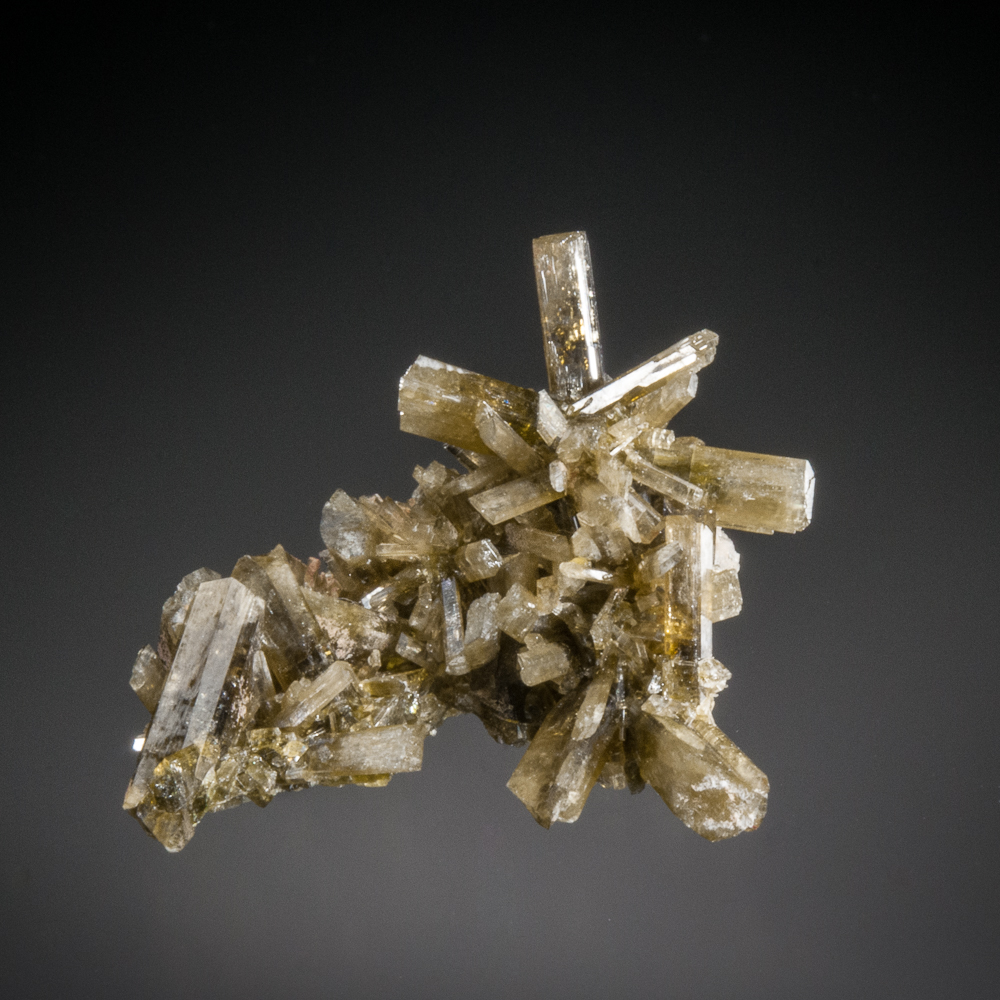
Clinozoisite, Cerro San Cristobal, San Vincente de Cañete,
Cañete Province, Lima Dept., Peru – 4.3 cm
Clinozoisite twin, Cerro San Cristobal, San Vincente de Cañete,
Cañete Province, Lima Dept., Peru – 3.5 cm
Clinozoisite twin, Cerro San Cristobal, San Vincente de Cañete,
Cañete Province, Lima Dept., Peru – 8.6 cm
I want to highlight one other great find that is relatively recent – the spectacular iron-cross twins of pyrite from Gachalá, Cundinamarca, Colombia, discovered about a year ago (I believe the ones available in Tucson were from the original find, as opposed to new production). The term “iron-cross twin” refers to twinned pentagonal dodecahedra, the edges of which cross at right angles. Well-defined iron-cross pyrite twins have always been uncommon and sought-after. Most are small, and often incomplete. These are quite large for iron-cross twins – they are pretty spectacular. One note about these: they have been mislabeled as goethite or limonite after pyrite. They are not pseudomorphs. In fact, they are pyrite, with a very thin surface layer of goethite.
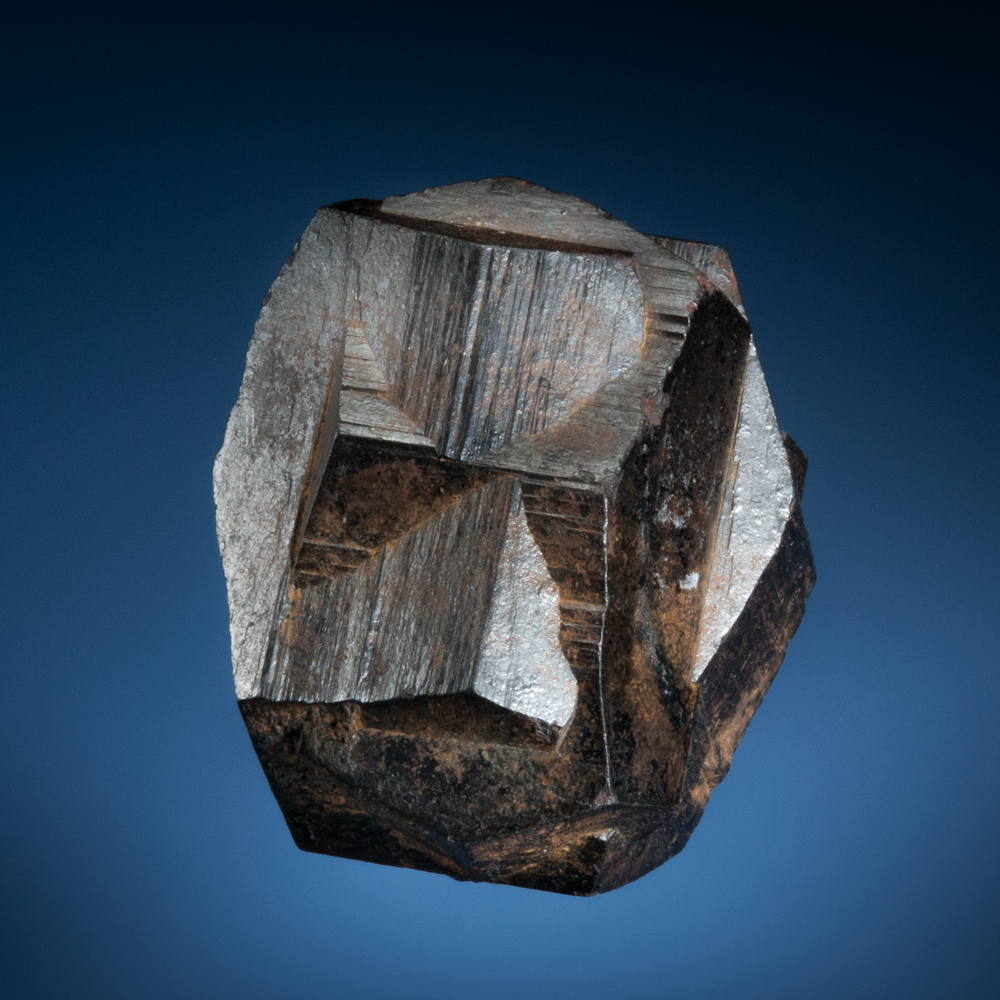
Pyrite Iron-Cross Twin, Gachalá, Cundinamarca, Colombia – 5.0 cm
Over to Africa, some great specimens. In Tanzania, the Merelani occurrences continue to produce very fine specimens of a number of minerals, while a few specimens from finds in recent years have surfaced as well.
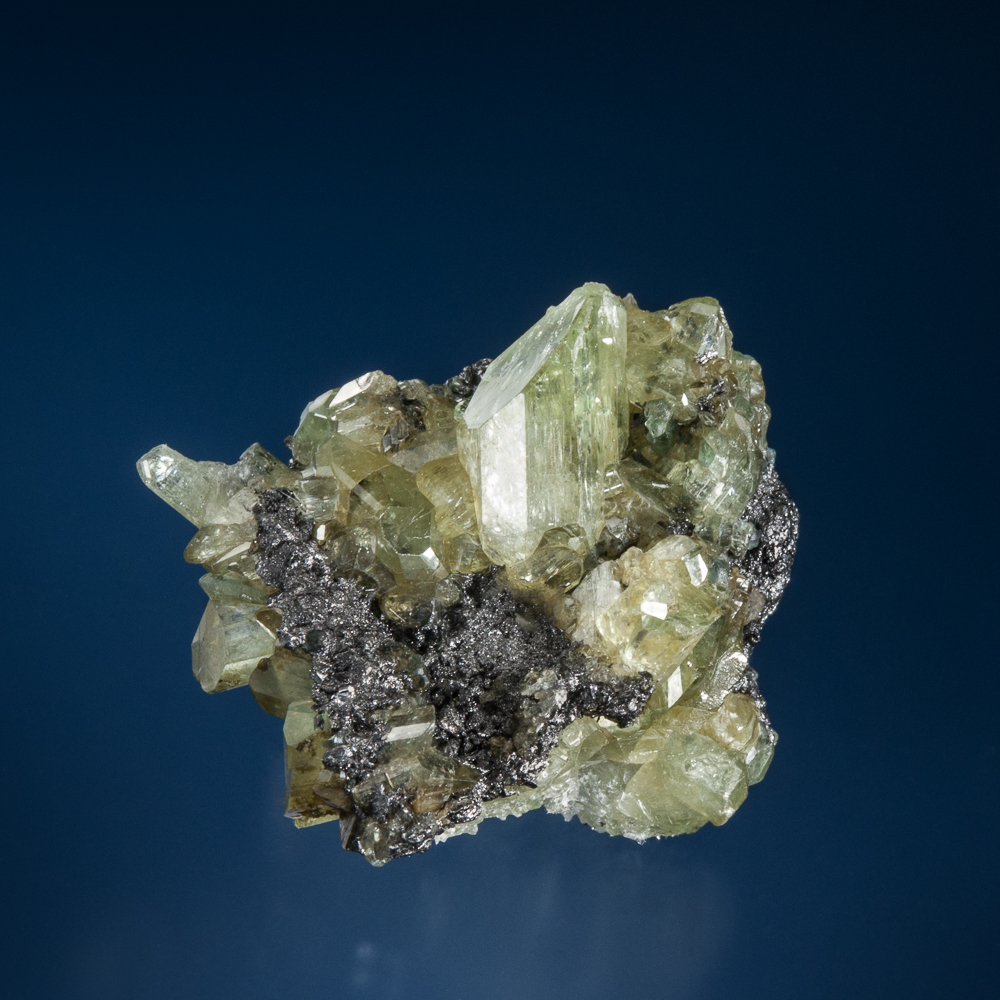
Diopside with graphite, Merelani Hills, Lelatima Mountains, Manyara, Tanzania – 3.7 cm
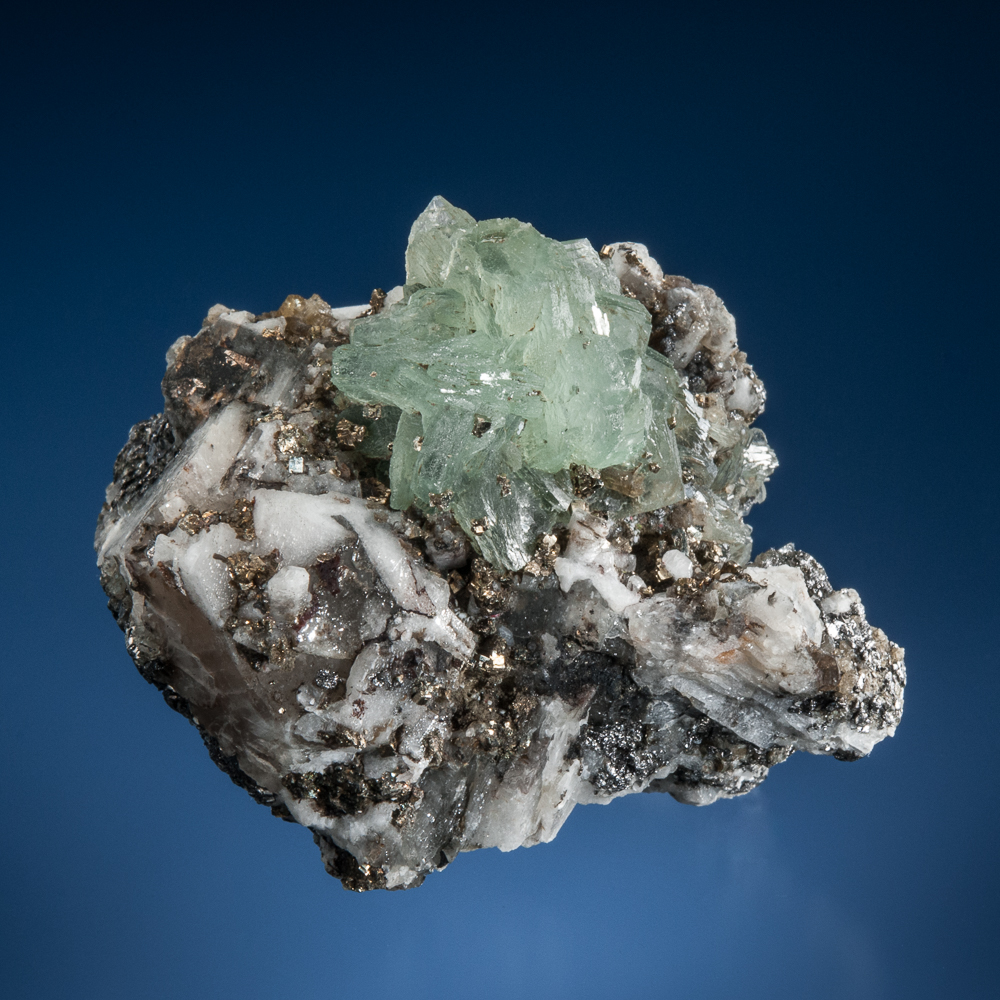 Prehnite, Merelani Hills, Lelatima Mountains, Manyara, Tanzania – 5.3 cm
Prehnite, Merelani Hills, Lelatima Mountains, Manyara, Tanzania – 5.3 cm
From the finds in 2012-13, I managed to acquire a world-class alabandite crystal.
Alabandite, Merelani Hills, Lelatima Mountains, Manyara, Tanzania – 6.8 cm
From Malawi, there have been more first class specimens available from the the occurrences at Mt. Malosa and Mulanje, including arfvedsonite, eudidymite and zircon.
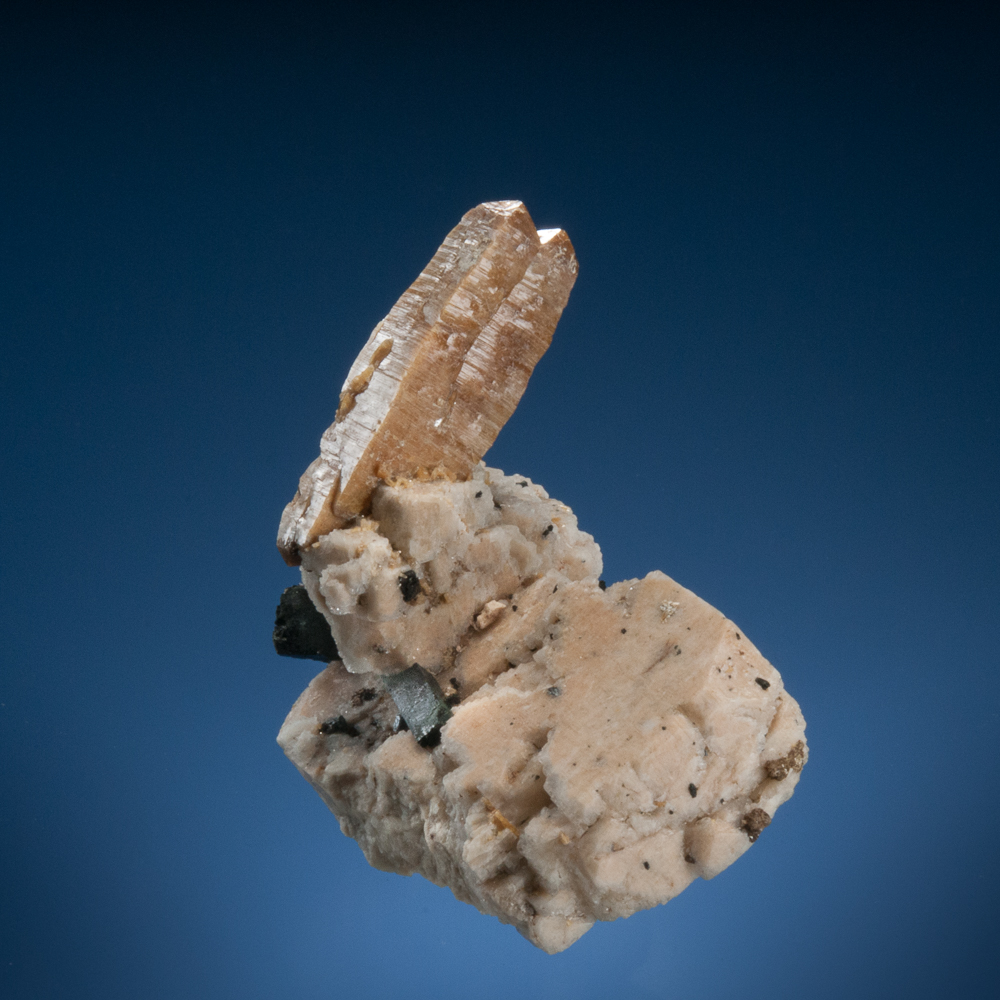 Zircon, Mount Malosa, Zomba District, Malawi – crystal 3.2 cm
Zircon, Mount Malosa, Zomba District, Malawi – crystal 3.2 cm
Over the years, the very well-known almandine occurrence at Vrondolo, Madagascar, has produced some unusually fine crystals. This occurrence is a fair distance up a small mountain – it takes hours to reach it on foot. Most often, the crystals from here are slightly to heavily chipped when extracted, because they are found frozen in solid rock. However, I found a small recent group of specimens including crystals that grew into open spaces, as well as other crystals extracted in super condition. These are really nice garnets!
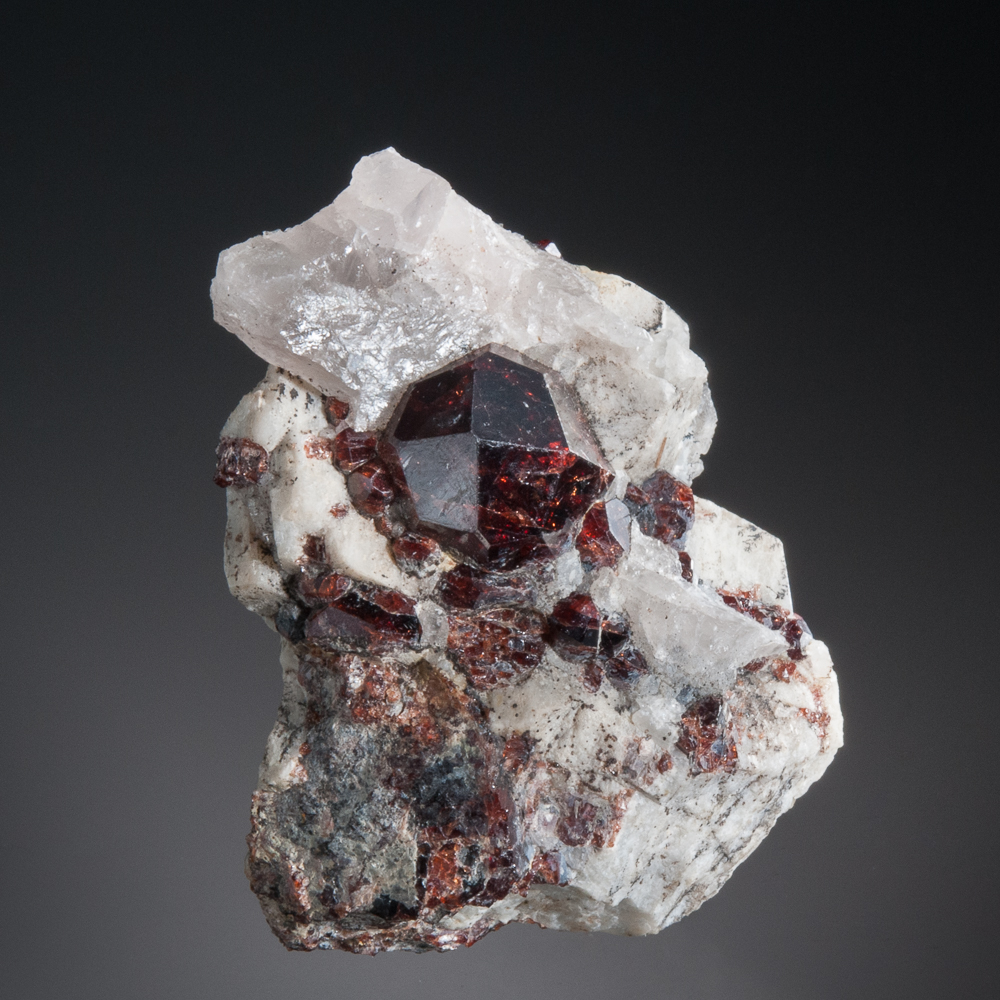
Almandine, Vorondolo, Antananarivo, Madagascar – 4.5 cm
Last from Africa, Morocco continues to produce excellent specimens of many minerals – the golden age of Moroccan minerals continues. Because these finds have been known generally or written up by others, I won’t dwell too much on them in this report – there will be many fine Moroccan specimens coming on the website over the next few months. However, I want to highlight some Imilchil material that I think is noteworthy. For some time, we have seen small dark garnet crystals from Imilchil. Some of these crystals have been found to be the titanium-rich garnet group member, schorlomite, while I’m told most analyzed specimens are actually titanium-rich andradite, not enough titanium to be schorlomite. A new find at Anemzi (the same Imilchil-area locality that produces the fine green fluorapatite crystals, and has produced nice magnetites) has produced some of the nicest of these dark andradite crystals I have seen from Imilchil. At their finest, the crystals are sharp with beautiful morphology, and a good number of the specimens are comprised of a stack of these crystals. Some specimens have small, sharp, octahedral magnetite crystals in association – they are sparse, but a neat pairing. Independent from the andradites, Anemzi has produced some sharp magnetites lately as well, making for very nice specimens.
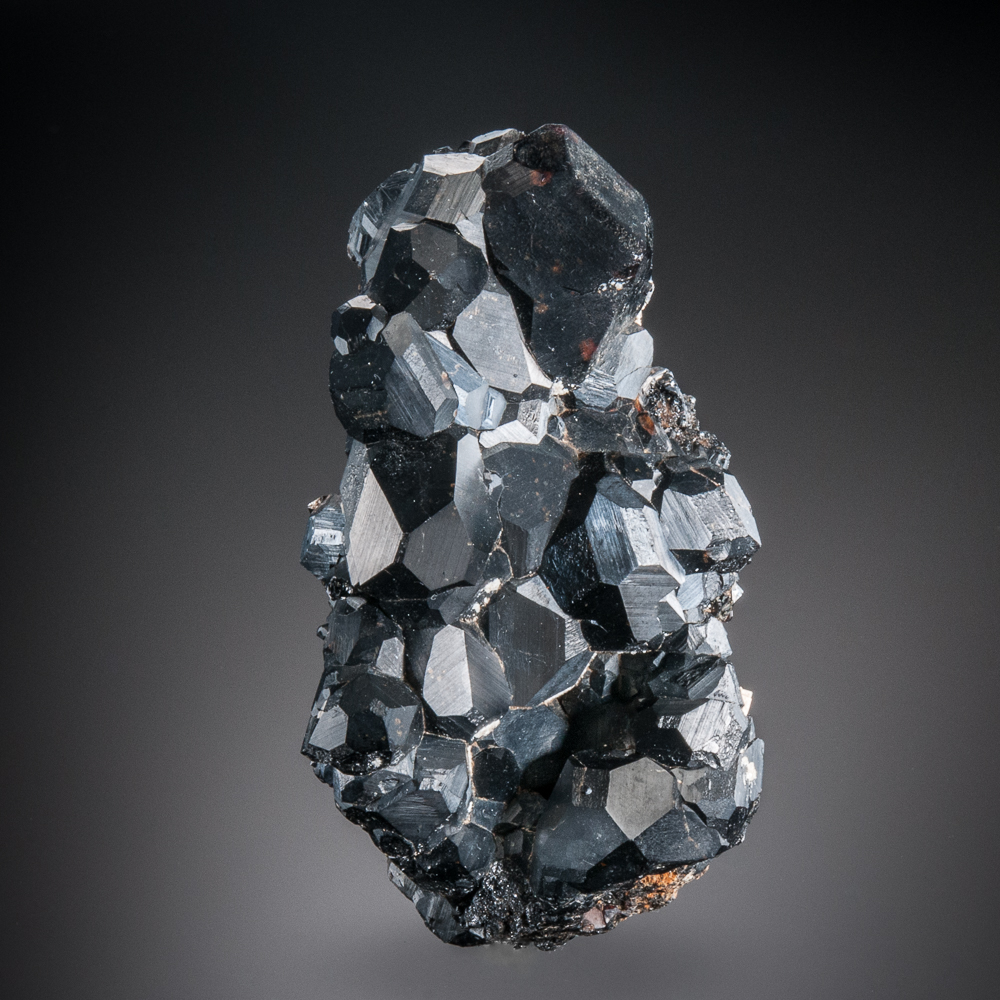
Andradite, Anemzi, Imilchil, Er Rachidia, Morocco – 7 cm
Andradite, Anemzi, Imilchil, Er Rachidia, Morocco – 3.5 cm
Magnetite, Anemzi, Imilchil, Er Rachidia, Morocco – 4.4 cm
My final mineral entry is from China. I feel that the find of fluorite from Fujian deserves a mention, even though China has produced so much fluorite over the years. These new ones are the fluorites that have been dubbed “tanzanite fluorite” by several dealers. These have been available since early 2017, and they were not widespread this year at Tucson. The ones available were quite expensive. This locality has produced a range of fluorite – the most tanzanite blue-purple is from the one 2017 find, while other blues and purple hues have been recovered as well. I’ve been told there is “no more” – of course!!! – and we’ve all heard that so many times before, so skepticism is certainly warranted! I personally will believe it when I see it. However, I didn’t see as much as I expected and hoped, so we’ll see. Moreover, most of the specimens I did see were significantly contacted and/or damaged. I believe this is not only reflecting the way they were collected (perhaps in some cases with less care than we’d like), but also due to the nature of the occurrence. Many of these seem to have formed in very tight and narrow spaces, and would have been exceptionally difficult to extract without any contacting issues. I think the overall story of this locality will be clearer over time. Given that there are several colour hues and crystal habits from this locality, so it seems likely there was more than one pocket. These are beautiful fluorite specimens!
Fluorite, Xiayang, Yongchun Co., Fujian, China – 5.3 cm
Fluorite, Xiayang, Yongchun Co., Fujian, China – 3.4 cm
Fluorite, Xiayang, Yongchun Co., Fujian, China – 5.2 cm
A Remarkable Emerald
My friend John White came upon a remarkable emerald specimen from Pakistan and I want to share a photo. I’ve never seen anything like it, and much more important, John (you likely know, the former curator of the Smithsonian Institution’s mineral collection) has never seen anything like it! It is available.
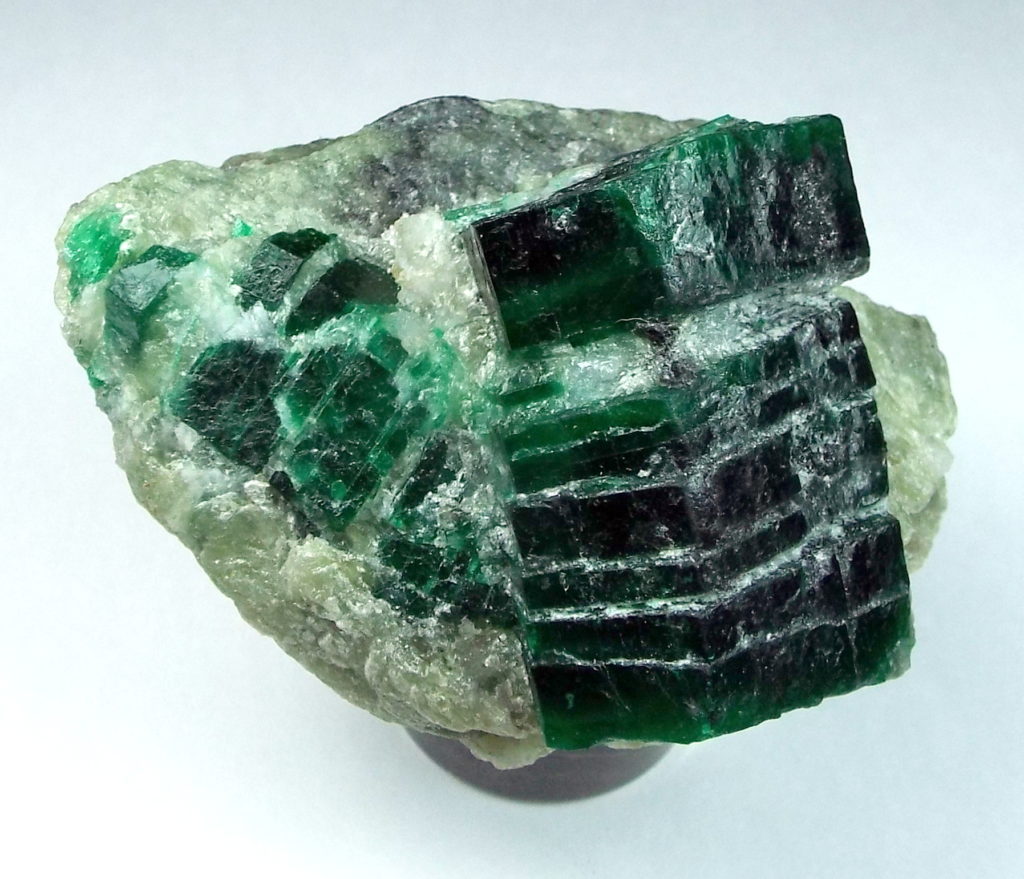
Beryl, var. emerald, Guijar Kalay Valley, Swat District, Khyber Pakhtunkhwa, Pakistan.
The larger crystal is 3.5 cm tall.
Friends
Tucson 2018 was a great time, with lots of great friends and the beauty of the Sonora Desert. Thank you all!
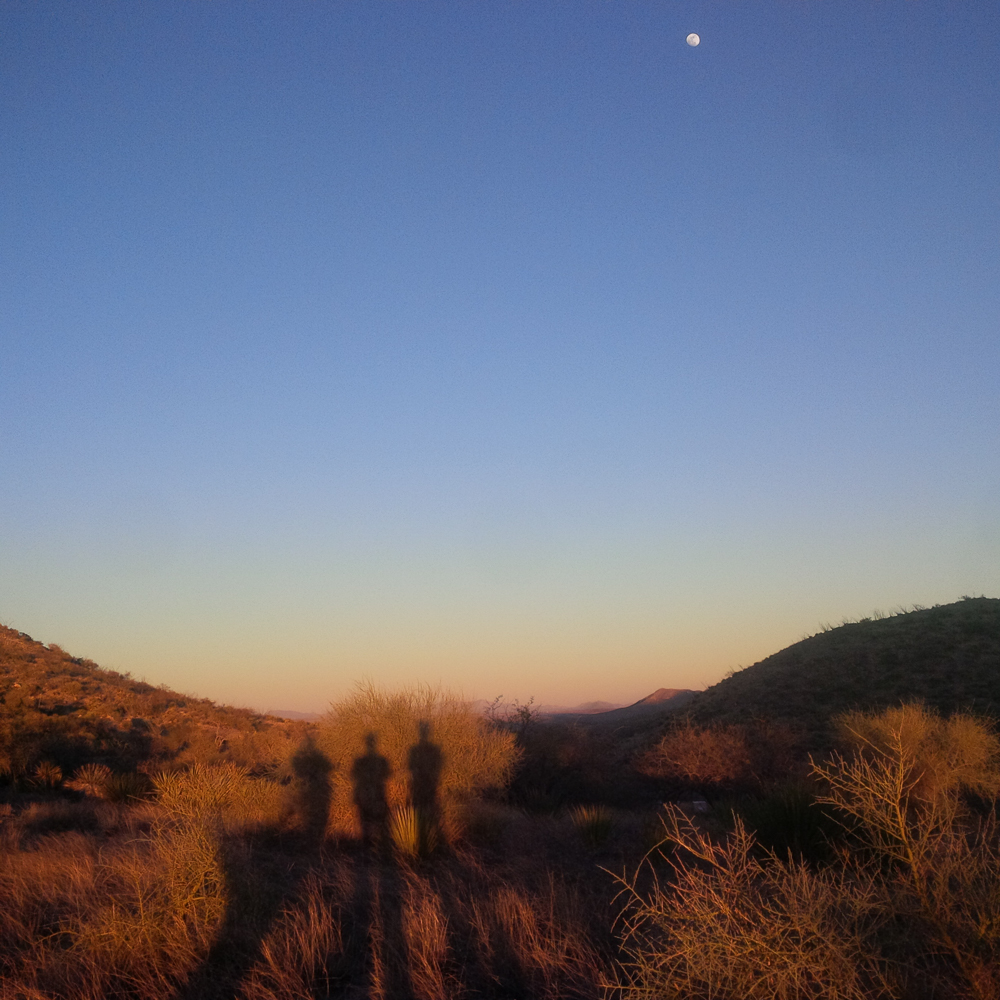
Evening shadows (I believe the order is Don Doell, me, John Betts)
Mineral songs around the campfire, led by Dave (of course!)
From left: Malcolm Southwood, John Veevaert, John Betts, Don Doell, David Joyce and Angela Southwood
Thank you again Carol, Dave and Riley, for a wonderful time!
Until next year, so long, Tucson…
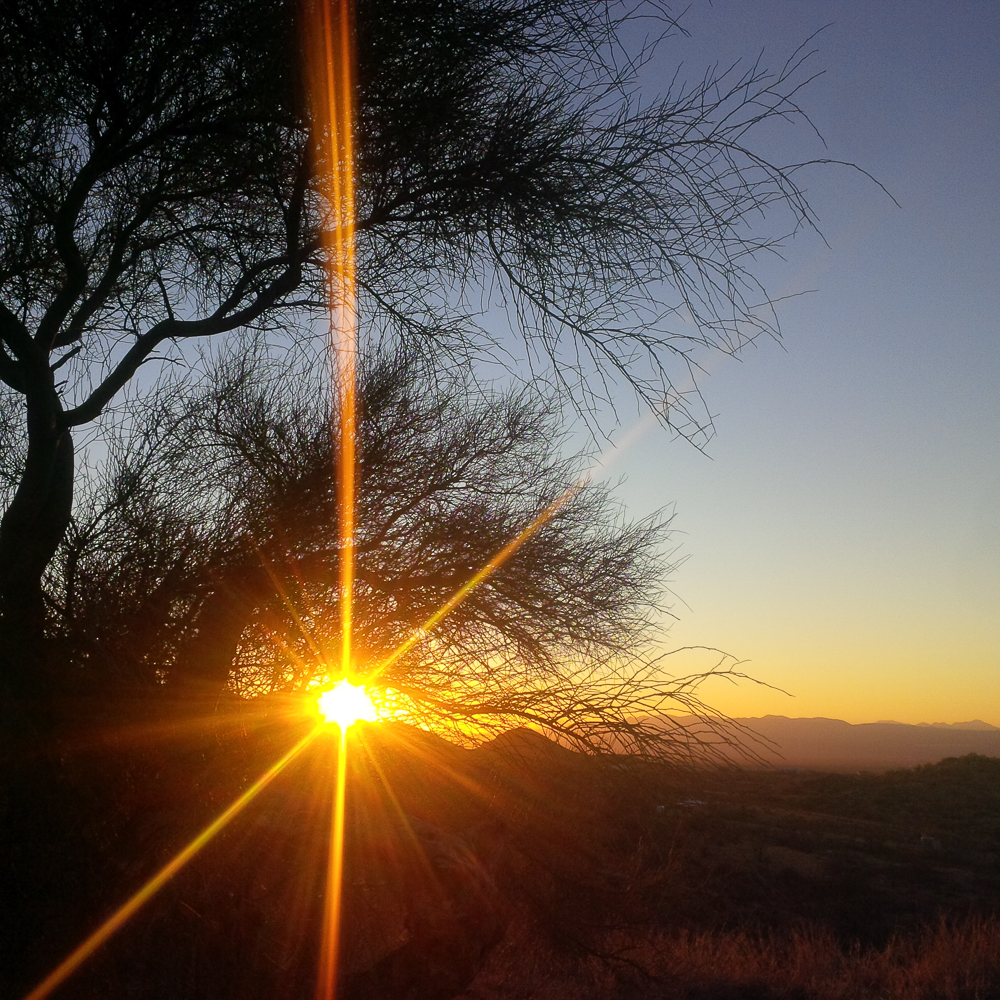
Home! And… Rudy!
As great as it was, it’s wonderful to be home. The warm sun of the Tucson desert having recharged me, I’m happy to be back out in the winter woods.
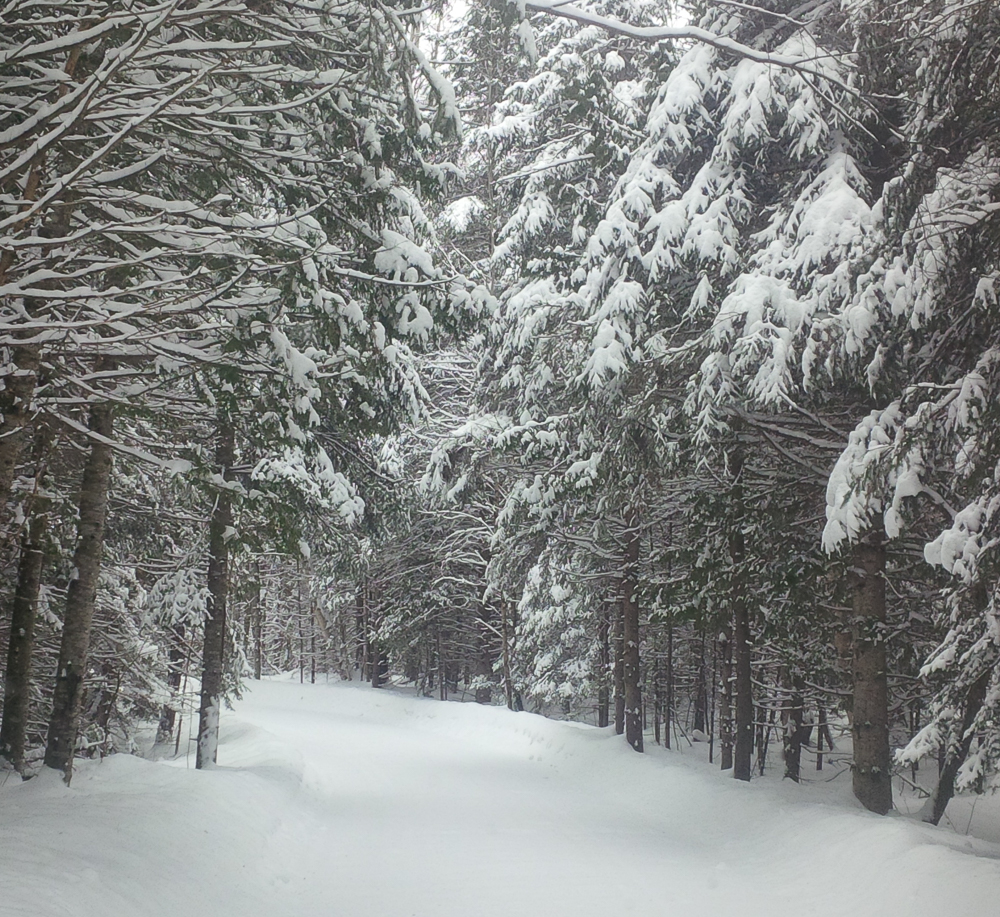 Our snowy woods, near Bancroft, Ontario
Our snowy woods, near Bancroft, Ontario
Sunny winter morning, Bancroft, Ontario
And as many of you know, this means I’m back to once again sharing fun with young Rudy, our Labrador Retriever puppy.
 Dad, can I join you on the couch?
Dad, can I join you on the couch?
First shipping run to Bancroft.
Dad, I’ll drive.
In only a couple of months he has transformed from tiny puppy to young dog. He’s gleeful about pretty much everything.
Rudy is of course new to all this mineral business. Our founding Labrador Retriever, Emery, supervised all operations – he was the Chairman of the Afternoon Snooze Committee and comprised our IT Department, although he slept through most of our business operations. It will be a while until Rudy is ready to step into Emery’s higher roles, but he is a great little supervisor. For now, he is happy to be a particularly active part of all packing, shipping and particularly unpacking operations. He has delighted in founding our Playful Mayhem Department.

What do you mean, my office chair is for “sleeping” while you work?
With lots of Tucson minerals to come, Rudy and I will do our best to get them online over the next few weeks!


